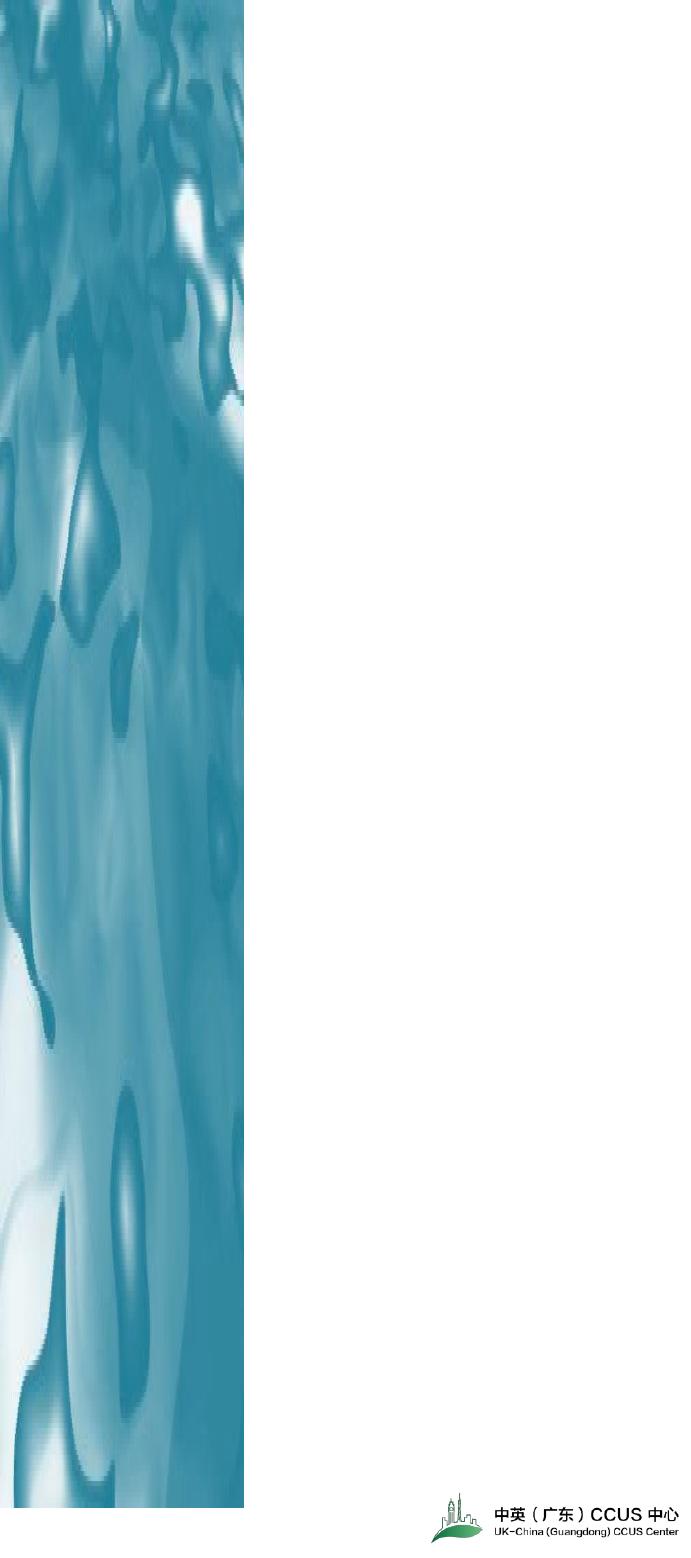CO2OffshoreStorageinChina:ResearchReviewandPlanforDemonstrationProject在中国进行离岸封存:研究回顾和示范项目计划DraftReportUpdatedon18May2015XiaolongLI1,2,DiZHOU1,3,PengchunLI1,3,YingyuanWU1,2,XiaochunLI1,4,NingWEI1,4,StuartHASZELDINE1,5,BillSENIOR1,6,YutongSHU1,5,JiaLI1andYiCHEN1李小龙1,2,周蒂1,3,李鹏春1,3,吴颖媛1,2,李小春1,4,魏宁1,4,StuartHASZELDINE1,5,BillSENIOR1,6,舒宇彤1,5,李佳1,陈弋11GuangdongCCUSCentre广东南方碳捕集与封存产业中心2CNOOCLimitedShenzhen中国海洋石油深圳分公司3SouthChinaSeaInstituteofOceanology,ChineseAcademyofSciences中国科学院南海海洋研究所4InstituteofSoilandRockMechanics,ChineseAcademyofSciences中国科学院武汉岩土力学研究所5UniversityofEdinburgh爱丁堡大学6SeniorCCSLimitedSeniorCCS咨询公司ReportNo.D01/2015Acknowledgements致谢SpecialthanksgototheNationalDevelopmentandReformCommissionandtheGuangdongDevelopmentandReformCommissionforsupportingtheCO2offshorestorageprojectresearchactivitiesintheSouthChinaSea.ThanksalsoforthesupportoftheBritishConsulateGeneraltoGuangzhouthroughtheStrategicProsperityFund(SPF),andMs.AdeeZaiandMr.Royfororganizingtheproject.WealsoappreciateknowledgecontributiontotheoffshorestorageworkshopbyMs.LingDai(CNOOC)andotherCNOOCcolleagues,ProfBoPENG(CUP),ProfQianguoLIN(GCCSI),Dr.MikeCarpenter(DNVGL),Dr.BruceHill(CATF),ProfJohnSarlis(ShellCansolv),Mr.TimBertels(Shell),ProfXiJiang(LancasterUniversity),andProfPetaAshworth(AshworthConsultancy).ThankstoMs.YEBihanfororganisingartediting.感谢国家发改委和广东省发改委对在南海进行二氧化碳封存项目研究活动的支持。感谢英国驻广州使馆通过战略繁荣基金对项目的支持,感谢宰培女士和何为之先生协调本项目。我们也感谢代玲女士及其他中海石油的同事,彭勃教授,林千果教授,MikeCarpenter博士,BruceHill博士,JohnSarlis教授,TimBertels先生,姜曦教授和PetaAshworth女士过去对广东省二氧化碳封存研讨会的贡献。感谢叶碧涵女士协调报告的美工和排版。TableofContentsIntroduction..........................................................................................................5BackgroundInformation.................................................................................................................................................5SupplyChainRelatedtoOffshoreCO2Storage............................................................................................................6TheValueofDemonstratingOffshoreCO2StorageinChina........................................................................................6TheAimoftheReport....................................................................................................................................................6SelectionofOffshoreStorageDemonstrationSite.............................................9Dataandprocedures.....................................................................................................................................................9ScoringandrankingproducingoilfieldsforCO2storagesuitability.............................................................................11Discussiononthecandidatesites................................................................................................................................16ConclusionsandSuggestionsonSiteSelection..........................................................................................................19PotentialofReuseExistingInfrastructure:PreliminaryFinding......................32StatusofHuizhouOilandGasFields..........................................................................................................................33ThePotentialtoReuseFacilitiesforCO2OffshoreTransportation..............................................................................34PlatformRetrofitandReusePotential..........................................................................................................................35ReuseofWells............................................................................................................................................................36RecommendationforOffshoreCO2StorageResearchandDemonstrationinNorthernSouthChinaSea..................................................................................41GeneraltimetableforGuangsongOffshoreCCUSProject..........................................................................................41FeasibilityStudiesforoffshoreCO2Storage................................................................................................................41Reference............................................................................................................45Appendix.............................................................................................................47目录报告介绍...................................................................................................................9背景信息.....................................................................................................................................................................9示范离岸二氧化碳封存涉及的产业链.................................................................................................................9在中国示范二氧化碳离岸封存的价值...............................................................................................................10本报告的目的和意义...............................................................................................................................................8离岸示范场地的筛选.................................................................................................23资料和方法..............................................................................................................................................................21生产油田的CO2封存适宜性评分和排队...........................................................................................................23候选封存场地讨论.................................................................................................................................................27结论和建议..............................................................................................................................................................31现有基础设施再利用潜力:初步分析结果......................................................................39惠州油气田的基本状况.........................................................................................................................................40现有设备再利用于二氧化碳离岸运输的潜力..................................................................................................41平台再利用和改造潜力.........................................................................................................................................41油井再利用..............................................................................................................................................................42南海北部离岸CO2封存研究和示范建议........................................................................43广东省离岸CCUS项目总时间表........................................................................................................................43离岸CO2封存的可行性研究................................................................................................................................43参考资料.................................................................................................................45附件.......................................................................................................................495IntroductionBackgroundInformationGuangdong,asaprovinceinsouthernChinawithapopulationof106million,isoneofthefirstfivelow-carbonprovincesinChinaandishostingtwopilotcarbonmarkets(GuangdongandShenzhen).TheGuangdongprovincialgovernmentrecognizestheimportantroleofCarbonCapture,UtilisationandStorage(CCUS)technologiesincontrollinggreenhousegasemissions.CCUSwashighlightedasanimportantcollaborationareainajoint-statementsignedbetweentheGuangdongDevelopmentandReformCommission(GDDRC),andtheUKDepartmentofEnergyandClimateChange(DECC).Followingthesigningofthejointstatement,theGuangdongCCUSCentre(hereinafterreferredtoastheCentre)wasestablishedinDec2013.ThecoregoaloftheCentreistodeveloppolitical,technical,industrial,financialandregulatorycapacitytoenablelarge-scaleintegratedCCUSdemonstrationprojectsinGuangdong.TheCentre,throughGDDRC,invitedChinaNationalOffshoreOilCorporationGroup(CNOOC)tojointheCentre,whichitdidinFebruary2014.TheCentreandCNOOCShenzhenjointlyhostedthefirstoffshoreCO2storageworkshopon9-10Dec2014.Followingtheworkshop,theCentre,withsupportfromcolleaguesinCNOOCShenzhen,drafteda15-yearworkplantosupportthedevelopmentofapilotcapture,transportChapter1Figure1-1SupplyChainofCarbonCaptureandStorageTechnology(IEAGHG,2012:4)6andstoragefullchainprojectandtopavethewayforalarge-scalemilliontonneCCUSprojectintheprovince.TheGuangdongprojectiscriticaltoChina’seffortstoreduceGHGsfromfossilpowergiventhelackofonshorecarbonstoragepotentialinSoutheastChina.TheCentreenvisionsthat,ifsuccessful,GuangdongandthePRMBcouldserveasahubforCO2insoutheastChinaprovidingcommercialscaleoffshoreCO2storageopportunitiesfortheregion.SupplyChainRelatedtoOffshoreCO2StorageAccordingtothecurrentsupplychainmodel(Figure1-1),CO2offshoregeologicalstoragewouldprovidecommercialopportunitiesforprojectdevelopmentcompanies(e.g.oilandgascompanies,professionalCO2storageoperators,utilitiesandtransportationcompanies),EPCinstitutes,consultingcompanies,andrelevantproductandtechnologyservicecompanies.Apartfromdirectparticipation,thesecondtierofthesupplychainwouldincludemajorEPCandconsultingcompaniesprovidingreservoirandoilfieldsservices,andrelevantequipmentandsubseaandoffshoreengineering.Thethirdtiersupplierswouldprovidewiderproductandtechnologyservices.Inaddition,offshoreCO2geologicalstoragewouldprovidenewopportunitiesforthecurrentengineeringandfinancialserviceindustries,suchasqualificationservices(e.g.DNVGLhasdevelopedarecommendedpracticeforCO2storage),insuranceservices(e.g.ZurichInsurancehasdevelopedaCO2geologicalstorageinsuranceproduct).TheValueofDemonstratingOffshoreCO2StorageinChinaFromtheChineseperspective,China’soilandgas,servicesandequipmentmanufacturingfirmsshouldwidentheirfocus,andconsiderCO2storageasaservicebusinessandafutureopportunity-insteadofapureenvironmentalinvestment.DevelopinganddemonstratingCO2offshorestoragehasthefollowingsixstrategicimplications:(a)Achievingadeepcutingreenhousegasemissions;(b)ContributingtomarineeconomicdevelopmentinChina,andtowardsachievingthemarineSilkRoadagenda;(c)Contributingtooffshoreengineering-relatedequipmentmanufacturing,servicesandadvancedtechnologyR&D,andreducingthecostofapplyingoffshoretechnologies;(d)Consolidatingapotentialoffshoreengineeringandservicesindustryhub,andincreasingtheexportcapacityandcompetitivenessofoffshoreengineeringproducts;(e)OffshoreCO2storagehelpslarge-scaleinfrastructuredevelopmentandimplementation;(f)Chineseoilandgascompanieswillbenefitfromdevelopingoffshoreoilfields.TheAimoftheReportThisreportisareviewofexistingresearch,whichrevealstheselectionofoffshorestoragedemonstrationsite,identifiesthepotentialtoreuseinjectioninfrastructures,andofferssuggestionsonoffshoreCO2storageresearchanddemonstrationinnorthernSouthChinaSea.Inaddition,thissummarywillalsohelptoselecttechnicallyandeconomicallysuitablesitesforstoring1milliontonneofCO2peryear.ThefinalaimofthereportistolayfoundationforthepilotinjectionaswellasFrontEndEngineeringDesignofGuangdongOffshoreCCUSproject(GOCCUS),topromotetheconstructionandoperationofGOCCUSproject,andtokick-offanindustryCO2offshorestorageprogrammeinnorthernSouthChinaSea.7报告介绍背景信息拥有1.06亿人口的广东省是南中国首批(5个省)列入低碳省份的地区之一,同时省内有两个(广东和深圳)试点碳市场。广东省政府重视碳捕集、利用与封存(CCUS)技术在遏制温室气体排放上的作用。广东省发改委(GDDRC)在与英国能源与气候变化部(DECC)签署联合声明时将CCUS划为重点合作领域。随后,中英(广东)CCUS中心(于2015年1月正式注册为广东南方碳捕集与封存产业中心,以下简称为中心)在2013年12月成立。中心的核心目标是协调和推动省内CCUS相关的政治、技术、工业、金融和法规力量,以促进大型、完整的(捕集、利用和封存)CCUS示范项目建立与发展。2014年2月,借助广东省发改委的正式沟通,中国海洋石油(CNOOC)接受中心邀请并成功成为中心成员单位。2014年12月9-10日,中心与中国海洋石油深圳分公司共同举办了第一届二氧化碳封存研讨会。中心随后又在中国海洋石油深圳分公司同事的协助下起草了一份未来15年工作计划建议,来支持试点碳捕集、运输和封存全链条项目的开发,为省内大型百万吨级CCUS项目的发展奠定基础。由于中国南部地区陆上封存二氧化碳潜力匮乏,该项目对中国火电产生的温室气体减排有重要意义。中心预期,如果项目可以成功开展,广东及珠江口盆地将成为中国南部地区二氧化碳商业规模离岸封存的中心。示范离岸二氧化碳封存涉及的产业链根据目前二氧化碳运输与封存的供应链模式(图1-1),二氧化碳离岸地质封存会为项目开发企业(包括石油与天然气公司、专门的封存公司、电力公司、运输公司)、承包机构和顾问公司,以及相关产品及技术服务公司带来新的商业机会。除了直接参与的企业,供应链的第二级包括主要承包商和顾问公司,涵盖盆地服务、油井服务、相关设备以及海底和海洋工程。第三级供应商包括更广泛的产品和技术服务。此外,二氧化碳离岸封存还会为许多现有的服务行业带来新的机会,包括认证服务(如挪威船级社积极投入CCS标准制定)、保险服务等。如苏黎士保险、瑞士再保险等保险公司与英国CCS协会合作,在2012年为二氧化碳封存所带来的产业机会进行过深入的评估。第一章图1-1CCS技术的供应链(国际能源总署温室气体中心,2012:4)8在中国示范二氧化碳离岸封存的价值对于中国而言,中国的海洋石油和天然气生产、服务和装备制造公司需要拓宽观念,把二氧化碳封存作为一项新兴的基础设施服务的产业,看作一个机会,而不是仅仅考虑为一项单纯的环保投资。在中国开发和示范离岸封存技术有六点战略意义:一是有利于大幅度降低温室气体排放;二是有利于中国海洋经济的发展;三是有利于海洋工程相关装备制造,服务和先进技术的研发,降低应用相关技术的成本;四是有利于发展和巩固海洋工程和服务产业枢纽基地,增加海工产品出口能力和竞争力;五是有利于大型基建项目的实施和开发;六是有利于中国企业在海外开发油田。本报告的目的和意义该项目将会启动南海工业级碳封存项目的第一部分,其目的在于总结回顾已有研究,形成一份评估盖层质量的正式报告,确定注入平台再利用潜力,以及制定未来离岸碳封存工作的协调方案。在广东省进行离岸封存研究和示范活动的目的是为25万吨级碳试注做准备,并挑选出在技术和经济上都比较适合进行年均百万吨碳封存的场地,同时确定在南中国进行长期大规模碳封存的理想地点。9SelectionofOffshoreStorageDemonstrationSiteCO2storageisanessentialpartofCCUS.AssessmenthasshownthatthepotentialofCO2storageonshoreGuangdongislimited,whilelargepotentialexistsinoffshoresedimentarybasinsinnorthernSouthChinaSea(GDCCSR-SCSIO,2013)1.Especially,thenearbyPearlRiverMouthBasinhastheeffectivestoragecapacity1of~300GtCO2(Zhouetal.,2011).If10%ofthiscapacitymaybeused,thePRMBcouldstoremorethan300yearsofGuangdong’scurrentlargepointsourceemissions(Zhouetal.,2013).OffshoregeologicalstorageistheonlyviableoptionofCO2storageforGuangdong.ItmightbealsotheonlyviableoptionofCO2storageforsoutheasternChina,wheretheonshoregeologicalconditionissimilartothatofonshoreGuangdong.OffshoregeologicalstorageofCO2hasnumeroussocial,political,economic,andtechnicaladvantageswithrespecttoonshoregeologicalstorage,especiallyforheavilypopulatedareas(Schrag,2009).Ithas,however,anobviousdisadvantagethatthecostofoffshoreengineeringandoperationisusuallymuchhigherthanthecostonshore.OnepossiblewaytoreducethecostistoreuseexistinginfrastructureanddataofhydrocarbonproductionforCO2storage.Iftheexistinginstallations,suchasplatform,well,pipeline,andotherequipmentmayberetrofittedintoCO2service,andexistingmaybeusedinsitecharacterizationandinjectionplanning,thenthecapitalcostofCO2storagemaybereduced,andtheconstructiontimemaybealsoshortened.1FollowingthedefinitionofCSLF(2007),theeffectivestoragecapacityisaportionofthetheoreticalstoragecapacityconstrainedbythestorageefficiencyfactor,whichrepresentsasuitofgeologicalandengineeringlimitations.InordertofindCO2storagesiteforthefirstfull-chainoffshoreCCUSprojectinGuangdongProvince,weexamined16producingoilfieldsinthePearlRiverMouthBasinoffshoreGuangdong.Atfirst,weeliminatedfromconsiderationthefieldshavinggoodhydrocarbonpotentialthatwillnotbedepletedinthenext10years.ThentheCO2-EORpotentialwasanalyzedbasedonsimplecomparisonwithWestTexasandUKcontinentalshelf.Finallytheremainingfieldswerescreenedandrankedwithascoringtablebasedonpublisheddataonproductionstatus,trap,reservoirandcaprockgeology,andpotentialforinfrastructurereuse.Onthisbasisthreefields,theHZ21-1,HZ32-3,andXJ24-3wereselectedascandidatesites.TheiradvantagesanddisadvantagesorknowledgegapsforCO2storagewerediscussed.Suggestionsforfurtherworktofulfiltheknowledgegapsinordertomakefinalselectionwereproposed.DataandproceduresThePearlRiverMouthBasin(PRMB),withtotalareaof~200000km2,isthelargestsedimentarybasininthenorthernSouthChinaSea(Figure2-1).ThePRMBhasexperiencedextensivegeologicalsurveyandhydrocarbonexplorationsincethe1970’s.SourcerocksaremainlyEocenelacustrinemudstonesandOligocenecoal-bearingrocks,andreservoirsarefoundmainlyinNeogenemarineclasticandcarbonaterocks,andinUpperOligocenealternativecontinental-marinebeds.Sofar30oilfieldshavebeenfound,mostofthemaresmallwithprovedreserve<60milliontonnes(<438millionbarrels),onlytheLH11-1fieldhasprovedreserveof155Mt(1.13Chapter210billionbarrels)(Zhuetal.,2008;ZhuandMi,2010).SomesmallgasfieldsarealsofoundintheWenchangSagoftheZhu-3depression.Accordingto2008assessment(MLRCetal.,2008),thePRMBhasOOIP(“geologicalreserve”isChinesenomenclature)2.2billiontonnes(16billionbarrels)andOGIPis743billionm3.Theprovedoilreserveis0.58billiontonnes(4.2billionbarrels),andprovedgasreserveis58.6billionm3.ThesenumbersindicatethattheexplorationinthePRMBisimmature;withonly26%OOIPand8%OGIPhavebeenprovedby2008.InrecentyearsseverallargegasfieldshavebeenfoundfromthedeepwaterBaiyunSagoftheZhu-2depression,andcrudeoilreserveshavebeenenlargedsuccessfullyformanyproducingfields.Figure2-1SimplifiedgeologicalmapandcrosssectionAA’ofthePearlRiverMouthBasin.LocationsareindicatedfortheHaifengPowerPlant(HFPlant),andthethreecandidateoilfields.11Inthisdesktopstudywescreened16producingoilfieldsinthePRMBfortheirsuitabilityforCO2storage.Thegeological,petroleum,andproductiondataofthesefieldsupto2005or2007arepublishedinZhuetal.(2010)andCNOOC(2011).Weusedmainlythedatafromthesepublicationsasbasisforourstudy,buttheproductiondatawerepartiallyupdatedtotheendof2010.AsthePRMBisstillinthestageofactivehydrocarbonexplorationandproduction,itisimportantnottohinderthehydrocarbondevelopmentbyCO2storageactivities.Keepingthisasaprincipal,ourscreeningwasconductedwiththefollowingcriteria:thepossibilityofearlierdepletion,thepotentialofCO2-EOR,theeffectivestoragesizeincludingambientsalineaquifers,reservoirproperties,containmentqualities(caprock,fault,wellleakage),reusableexistingfacilities,andothertechnicalandeconomicalfactors(source-sinkdistance,waterdepths,etc.).ScoringandrankingproducingoilfieldsforCO2storagesuitabilityWiththedataandmethoddescribedinthelastsection,ourscreeningwasperformedinthefollowingsteps:1)Eliminatingthefieldshavinglargeremainingcrudeoilorhavinghighexpectationofreservesgrowthandthusdonothavethepossibilityofdepletionwithin10years.ThiswasmadebydiscussionwithCNOOCexpertsinreservoirdepartment;2)Rankingtheshort-listedfieldsusingconstructeddatabaseandscoringtable;3)Searchallthe16producingoilfieldsforthefield(s)havingsignificantsalineaquifersaboveproducingoilreservoirsbasedoncorerecords,welllogs,andmultichannelseismicprofiles;4)Analyzetheadvantagesanddisadvantagesofhigh-scoredfieldsbasedonallavailabledata,andidentifytheknowledgegapsinmakingtheselection.ItshouldbenotedthatintheStep3thehigh-remainingoilpotentialfieldsarealsoconsidered,andtheselectedfield(s)arenotjointthescoringandrankingprocessinStep2.Thesearebecauseweareinterestedinthesalineformations,thustheevaluationcriteriaaredifferentfromthosetheoilreservoirsaretobeusedinCO2storage.Afterthefirststep,7oilfieldswereselectedFromthe16oilfieldsinthePRMB.Forthesefieldswecompiledadatabaseusingmainlypublisheddataasbutupdatedtoendof2010withadditionaldatafromCNOOC.Thenasthesecondstepascoringtable(Table2-1)wasdesignedforrankingthesuitabilityoftheseoilfieldsforCO2storage.ThepotentialofCO2-EORshouldbeanimportantfactor,butithasnotbeenincludedinthetablebecausenodetailedevaluationhasbeenconductedforindividualfields.Theresultedscoresfortheselected7oilfieldsarelistedinTable2-2.Wefoundthatthedataoncaprockaremostlymissing,andseveralindexesareuniformoverthefieldsandthushavenoeffectonthescoring.ThemostvariantandthusinfluentialindexesareOOIP,potentialforreservegrowth,reservoirquality,trapdimension,andthepossibilityofreusingexistinginfrastructure.Afterthisstep,theHZ32-3andHZ21-1fieldshavingthehighesttotalscoresareselected.12IndexTypeWeightIndexWeightScoreGood(9)Fair(7)Ordinary(5)Poor(3)Bad(1)Productionstatus0.2Productiontime(a)0.1>2020~>1515~>1010~>5<5OOIP(Mt)0.2>2020~>1515~>1010~5<5Portionofrecovery(%)0.2>9090~>7070~>5050~30<30Potentialforreservesgrowth0.4LimitedMinorUnclearHighVeryhighWatercontent(%)0100~>9595~>9090~>8080~>70<70Reservoircondition0.25Totalthickness(m)0.2100~>7070~>5050~>3030~>1010Topdepth(m)0.21200~15001500~20002000~25002500~3000>3000Effectiveporosity(%)0.2>2525~>2020~>1010~5<5Effectivepermeability(mD)0.2>500500~>300300~>200200~50<50Horizontalcontinuity0.1GoodFairmediumPoorBadGeothermalgradient(℃/km)0.1<3030~<3434~<3737~<40>=40Pressurecoefficient0.1<1.051.05~<1.11.1~<1.151.15~1.2>1.2Caprock0.25Topcaprockmaximumthickness(m)0.3>100100~>7070~>5050~20<20Openfault0.2NoMinorMediumCommonAbundantLateralcontinuity0.2GoodFairmediumPoorBadBreakthroughpressure(MPa)0.1>1010~>55~>33~1<1Lithology0.2TightmudstoneMudstoneorevaporiteSiltymudstoneMuddysiltstone,limestoneSiltstone,fracturedlimestoneTightevaporiteTrap0.1Type0.2LargedomeDomeFaultednose/draganticlineFaultedblockLithologicalHeight(m)0.3>4040~>3030~>2020~10<10Area(km2)0.3>2020~>1515~>1010~5<20Faultactivity0.2NofaultOnemajorfaultinactiveSeveralfault,inactiveSeveralfault,activeSeveralfault,highlyactiveOthers0.2Re-useofinfrastructure0.5FavorableReasonablePossibleDifficultyImpossibleWaterdepth(m)0.3<100100~<200200~<300300~500m>500DistancetoCO2source(km)0.2<5050~<150150~<200200~300>300Table2-1ScoringschemeforthesuitabilityofoilfieldstoCO2geologicalstorage13TypeIndexWeightHZ32-3HZ32-2HZ32-5HZ21-1XJ24-1HZ19-3HZ19-2ProductionProductiontime0.0270.1470.1450.1090.1870.1430.0630.06OOIP0.0490.3630.1230.1230.1230.1210.0410.04Portionofrecovery0.0470.2870.2870.2890.3650.2070.2850.20Potentialforreservesgrowth0.0830.2430.2430.2490.7230.2490.7290.72Watercontent030.0050.0050.0050.0090.0050.0070.00ReservoirTotalthickness0.0550.2530.1530.1530.1570.3550.2590.45Topdepth0.0570.3550.2570.3530.1550.2530.1510.05Porosity0.0570.3570.3570.3550.2570.3550.2550.25Permeability0.0590.4590.4590.4550.2570.3570.3530.15Lateralcontinuity0.025Geothermalgradient0.02570.1870.1870.1870.1870.1870.1870.18Pressurecoefficient0.0290.1890.1890.1890.1890.1890.1890.18CaprockTopcaprockmaximumthickness0.075Openfault0.05Lateralcontinuity0.05Breakthroughpressure0.025Lithology0.05TrapType0.0390.2790.2790.2790.2750.1570.2170.21Height0.04590.4190.4150.2350.2370.3290.4170.32Area0.04590.4130.1470.3250.2310.0510.0510.05Faultactivity0.0390.2790.2790.2790.2790.2790.2790.27OthersRe-useofinfrastructure0.07550.3850.3870.5390.6850.3870.5370.53Waterdepth0.04570.2670.2670.2670.2670.2670.2670.26Source-sinkdistance0.0350.1950.1950.1950.1950.1950.1950.19Totalscore1.004.954.244.454.653.964.364.09Order1532746Table2-2Scoringresultsforselectedsevenoilfields.(Foreachfieldthefirstandsecondcolumnsarescoreandweightedscorerespectively.)Scoringresultsforselectedsevenoilfields.14Inthestep3,theXJ24-3fieldwasfoundhavingthick(>400m)salineaquifersabovetheoilreservoirs.Thesesalineaquiferscanbetracedlaterallytoadjacentoilfieldsandoverlainbythickcaprocksaccordingtoseismicprofilesandwellloggingdata.ThustheXI24-3fieldisalsoselectedasacandidatesite.FinallyweanalyzedthethesethreefieldsastheprimarycandidatesitesforthefirstCO2storagedemonstrationproject.Thelocationsofthesefieldsareshownin(Figure2-1).Majorfeaturesofthesecandidatesites,basedmainlyonthedatapublishedinZhuandMi(2010)andCNOOC(2011),arelistedinTable2-2anddiscussedinthissection.ThetheoreticalCO2storagecapacityofthesefields,listedinthelastbutthreerowofTable2-3,wasestimatedsimplybyvolumereplacementofrecoverableoilreserveswithsupercriticalCO2,wherethedensityofCO2estimatedfromthedensity/depthcurveofnorthernPRMBinFigure6ofZhouetal.(2011).15SiteHZ21-1HZ32-3XJ24-3Timeofproductionstart199019951994Provedoilreserve(Mt)15.829.730.1Recoverableoilreserve(Mt)7.920.328.9Recoveryby2010(%)88.791.844.4Potentialofreservesgrowthby2014LimitedGoodGoodWatercontent(%)98.565.688Numberofreservoirlayers88(onemainlayerwith75%reserve)21Reservoirtotalthickness(m)2630.416.6Oilcolumnheight(m)9.0~23.010.5~42.018.9~65.5Reservoirtopdepth(m)2821~30011955~22801872~2317Reservoireffectiveporosity(%)12.8~16.618.0~22.817.1~24.6Reservoireffectivepermeability(mD)68~317247~272954~1982Reservoiroriginalpressure(MPa)28.6~29.819.8~24.118.8~23.7Reservoirlithology&faciesSandstoneLittoraltodeltafrontSandstoneLittoraltodeltafrontSandstoneLittoraltodeltaicReservoirfaultsNoNoYesTraptypeDrapinganticlineDrapinganticlineDrapinganticlineTrapheight(m)11.5~23.012.2~46.035~64Traparea(km2)10.523.614.5Caprockthickness(m)>75CaprockfractureOnefaultconcealedCaprockcontinuityGoodGeothermalgradient(℃/km)33.33129.7Existinginfrastructure4-legjacketwith15slots,gasprocessingplatform,pipelinetoland4-legjacketwith12slots8-legjacketwith24slotsNumberofWells152216Waterdepth(m)11611099DistancetoCO2sourceinHaifeng(km)160200190CO2storagecapacity(Mt)5.713.716.2Advantages1)Oilproductionisclosetothelimit2)Morereusableinfrastructureincludinggasprocessingplatform,pipelinetocoastalterminal,CO2-resistantcomponents1)Largecapacity2)Severaladjacentoilfieldsfavorabletocapacityexpansion3)Highreservoirreliefthatisfavorableto“Next-generation”CO2-EORThicksalineaquifer(280mnetthickness)aboveoilreservoirs.DisadvantagesRelativelysmallanddeepaquifersPossibleinterferencetooilproductionSealqualityfortheuppersalineaquifersisuncertainCO2storagecapacityisestimatedsimplybyvolumereplacementofrecoverablereservesofoilwithsupercriticalCO2.Table2-3Mainfeaturesoftheselectedcandidatesites(Datasource:ZhuandMi(2010)andCNOOC(2011);datadeadlinebyend2007or2005unlessspecified.))Scoringresultsforselectedsevenoilfields.16DiscussiononthecandidatesitesTheHZ21-1oil&gasfieldTheHZ21-1fieldisthefirstproducingoilfieldandtheonlyfieldnowproducingbothoilandgasinthePRMB.Itstartedoilproductionin1990andgasproductionin2004.Thisfieldisadrapeddomeof10.5km2inarea(Figure2-2).Thereare8oilreservoirsatdepthsof2820~3010mand2gasreservoirsatdepthsof2350~2540mbelowseafloor.ReservoirsareuppermostOligoceneZhuhaiFm.toLowerMioceneZhujiangFm.sandstonesoflittoraltodelta-front/neriticfacies.Theoilreservoirshavesingle-layeraveragethickness3.8~40.2m,porosity13.3~17.3%,andpermeability4.2~867mD.Thegasreservoirsareofthickness25~42m,porosity9.5~18.1%,andaveragepermeability187mD.Thecrudeoilproducedfromthefieldisoflowdensity,lowviscosity,andlowsulphurcontent.Ontheformationlevelthecrudeoilhasdensity0.641~0.727g/cm3,viscosity0.33~0.74mPa·s,andsolublegascontent44~178m3/m3.Thegasreservoirsarecondensatesaturatedandcontain76.6%CH4and2.4%CO2.Thereservoirsareinnormalpressuresystemandhavestronglateralorbottomaquifersupport.Attheearlystageofoilproductionitwasobservedthatinmajorreservoirsthewatervolumewas100~200timesofoilvolume,andtheformationpressurereducedonly0.07~0.124MPaforproducing1%reserve.Thusthewaterfloodwasregardedasunnecessary,andtheplannedwaterinjectionwellwasturnedintoanoilproductionwellsincethen.ThequalityofcaprocksintheZH21-1fieldwasevaluatedbywell-loganalysis(Chenetal.,2007).The75mthickcaprocksat2676~2850mdirectlyoverlyingoilreservoirshaveaverageeffectiveporosity2%,permeability<0.02mD,andbreakthroughpressureaslargeas20MPa.ThetrapsoftheZH21-1fieldarecutbyonlyonefaultinitsnorthernedge.ThisfaultisaFigure2-2TheHZ21-1oil/gasfieldfromZhuandMi,2010).(a)Structuremapofthetop2970moilreservoir.(b)Crosssectionshowingtheoil(green)andgas(red)reservoirs.(c)Compositestratigraphiccolumn.)Scoringresultsforselectedsevenoilfields.17sealingfaultasevaluatedbyCNOOCexperts.ThusthecontainmentoftheZH21-1fieldisgood.TheHZ21-1fieldhasprovedreservesof15.75Mtoil,2056Mm3solublegas,and6735Mm3naturalgas.Theestimatedrecoverablereservesare7.9Mtoil,1281Mm3solublegas,and5400Mm3naturalgas.Bytheendof2010,thetotalproductionwas7.0Mtoil,1262Mm3solublegas,3822Mm3naturalgas,and0.6Mtcondensates.Bynowtheoilproductionisregardedasclosetothelimit,andasmallgasproductioniscontinuedtogenerateenergyforthisandnearbyplatforms.ThetheoreticalCO2storagecapacityoftheHZ21-1oilreservoirs,estimatedsimplybyvolumereplacementofrecoverablereserveofoilwithsupercriticalCO2,isonly5.7Mt.Astheplanneddemonstrationprojectneedsatleast20MtCO2storagecapacity,theuseofambientsalineformationsforCO2storageisessential.InordertoestimateiftheoilreservoirsintheHZ21-1fieldcanaccommodateCO2injectionatarateof1and2Mtpa(millionmetrictonneperyear)for20years,aprimaryCO2injectionmodelinghasconductedusingtheECO2NmoduleoftheTOUGH2computerprogramandbasedonthethickness,porosity,andpermeabilitydatafromonewell(Lietal.,unpublishedreport).Resultsshownthatthemaximumpressurebuildupat500mfromtheinjectionpointwasonly2.3%oftheoriginalformationpressure,andthemaximumCO2plumedispersionafter100yearswasonly4.5kmtothesoutheast.ThesesuggestitispossiblefortheHZ21-1oilreservoirsservingasthestoragesitefortheplanneddemonstrationproject.TheoilreservoirsintheHZ21-1fieldhaveseveraladvantagesforbeingusedinCO2storage:1)Inthefieldconventionaloilproductionisclosetothelimit,thusitispossibletoapplyCO2-EORorCO2storageinnearfutureyears.2)Thefieldhasgas-processingplatformandCO2-resistantcomponentsandthusismorefavorabletoberetrofitforCO2services,asdiscussedinChapter3ofthisreport.3)ApipelinefromHZ21-1tothecoastalterminalatZhuhaiisspareandmaybeavailableforCO2transportation.AmajorconcernforCO2storageintheHZ21-1fieldiswhetherthestoragesizeislargeenoughforthedemonstrationproject.Althoughourpreliminarymodelingindicateditcanaccommodate20yearsCO2injectionat2Mtparate,thisneedstobeconfirmedbyfurtherdetailedstudyusingalltheavailabledata.TheHZ32-3oilfieldTheHZ32-3oilfieldisadrapedanticlinedevelopedaboveagraniticbasementhigh.Theoil-bearingstratapinchouttothenortheast,sothefieldhascombinedstructuralandstratigraphictraps(Figure2-3).Thereare11oilreservoirsoccurringatdepths1955~2280mbelowseafloor.TheyaremadeofuppermostOligocenetolowerLowerMiocenelithicfeldspararenitewithdeltaictolittoralfacies.Auniquecharacterofthisfieldisthat81%ofitsreservecomesfromonesinglereservoirK-22,whichisasandstonelayerintheLowerMioceneZhujiangFm.,madeofthickcoarsesandstonedepositedinbradedchannelsofdeltaicplain.Thelayerhasaverageporosity25%,averageairpermeability2729mD,effectivethickness18.6m,oilcolumnheight42m,andoil/watercontact(OWC)at1997m.TheK-22reservoirpinchesouttotheeast.18TheoilproductionintheHZ32-3fieldstartedin1995.By2010itsprovedreservewas29.7Mt,andtotalproductionwas18.6Mt.Atformationlevelthecrudeoilhasdensity0.759~0.818g/cm3,viscosity0.75~4.39mPa·s.Thereisnogaslayerbutsmallamountofdissolvedgas.TheadvantageoftheHZ32-3fieldisitsrelativelylargeOOIPsuggestingalargerCO2storagecapacity(13.7MtCO2,morethan2timesofthatinoilreservoirsofHZ21-1,seeTable2-3).ThelargethicknessandhighreliefoftheK-22reservoirmaybeadvantageousfortheapplicationof“Next-generation”CO2-EOR.AnotheradvantageoftheHZ32-3fieldisthatitresidesinabeltofseveraladjacentfieldsandthusiseasytoexpanditsstoragecapacity.ThedistancesfromtheHZ32-3platformtotheHZ32-2andHZ26-1platformsareonly5.6kmand4.8kmrespectively.Incomparison,thedistancesfromtheseplatformstotheHZ21-1platformare25km.ThemajorconcernfortheCO2storageintheHZ32-3fieldistheoilcompanymightbeafraidofobstructingitsoilexplorationbyCO2storageactivities.TheXJ24-3oilfieldTheXJ24-3fieldisalsoadrapedanticlinedevelopedabovebasementhigh.Ithas21oilreservoirsatdepths1872~2317mbelowseafloor,composedofdeltaicandlittoralsandstonesinmiddletoupperportionoftheLowerMioceneZhujiangFm.andlowerportionoftheMiddleMioceneHanjiangFm.Thereservoirshaveaverageporosity17~25%,effectivepermeability54~1982mD,single-layerthickness<1~22.4m.Theoilproductionstartedin1994fromtheXJ24-3field.Itsprovedreservewas30.4Mt,andtotalproductionwas19.8Mtby2010.Atformationlevelthecrudeoilhasdensity0.796~0.869g/cm3,viscosity2.3~12.4mPa·s.Theseareultra-lowsaturatedoilreservoirswithoutgascaporgasintra-layer.Theamountofdissolvedgasislowerthan1m3/m3.InrecentyearstheXJ24-3oilfieldhasshownsignificantpotentialofreservesgrowth.ThereforeatthepresentweareconsideringonlythesalineaquifersforCO2storage.Fromwelllogswefoundabovetheoilreservoirsa>400mthicksandysectioninthelowerandmiddleHanjiangFm(MiddleMiocene).Thenetthicknessofsandstonesinthissectionisaslargeas280m(Figure2-4b).usingFigure2-3Thestructuremap(a)andcrosssection(b)oftheHZ32-3oilfieldinthePearlRiverMouthBasin(FromCNOOC,2011).Scoringresultsforselectedsevenoilfields.(a)(b)19seismicprofiles,thissandysectionmaybetracedatleast40kmlonginE-Wdirection(Fig.2-4c).IfthesesalineaquiferscanbeusedtostoreCO2,thestoragecapacitywillbeverylarge,andtheinfrastructureoftheXJ-24-3oilfieldmightbeusedtoreducethestoragecost.However,althoughwelllogcurvesshowthatthereisabout200mthickcaprocksectionintheupperHanjiangformation,atpresentwehavenodataonthesealingqualityofthesecaprocks.BecausetheXJ24-3fieldislocatedclosetothepaleo-PearlRivermouth,itssedimentsarethoughttoberelativelycoarseindicatingsealrisk.Inaddition,seismicprofilesindicatetherearefaultscuttingthroughbothsalineaquifersandcaprocks.Theleakagealongfaultsisalsoanimportantconcern.InsummarythemainpossibilityforstoragedemonstrationatXJ24-3isinoverlyingsalineaquifers,ratherthanindepletedoil/gasreservoirs.Thisisadifferentstoragepropositionwithmajoruncertaintiesandriskaroundstoragecharacteristicsandcontainment.Extensiveworkandprobablynewdataacquisitionandnewappraisalwellsarerequiredtoaddresstheseunknownsandtoprogressthisoption.ConclusionsandSuggestionsonSiteSelectionPreviousworksdemonstratedthatthepotentialCO2storagesitesforGuangdongProvinceresideoffshoreinthePearlRiverMouthBasin(PRMB).ThecostofoffshoreCO2storagewillbereducedifexistinginfrastructuresforoil/gasexplorationmaybereusedforstorage.Inordertofindasuitablestoragesiteforthefirstfull-chainoffshoreCCUSprojectinGuangdong,weexaminedandranked16producingoilfieldsinthePRMBbasedonpublisheddatafortheirpotentialofearlyabandonment,potentialofCO2-EORapplication,suitabilityingeologicalconditions,andpossibilityofreuseinfrastructureforCO2injectionandtransportation.Threefields,theHZ21-1,HZ32-3,andXJ24-3,wereshort-listedfromourscreening.Theirmajorfeaturesarereviewedinthisreport.Insummary,eachsitehasitsownadvantagesFigure2-4TheXJ24-3oilfield:(a)Structuremapandcrosssection(ZhuandMi,2010);(b)Thecompositestratigraphiccolumnshowingthesandysalineaquifers(inyellow)andcaprocks(inviolet)inMiddleMioceneHanjiangFm.(CNOOC,2011);(c)Amulti-channelseismicprofileshowingthearealextendofthesandysalineaquifers(FromCNOOC).20andknowledgegaps.TheHZ21-1fieldisadvantageousinitspossibleearliestabandonmentandhigherpotentialofinfrastructurereuse,butifitsstoragecapacityislargeenoughforthedemonstrationprojectneedstobeconfirmed.TheHZ32-3fieldhasrelativelyhigherstoragecapacityandCO2-EORpossibility,butitsoilproductionisstillactiveandmaynotwanttobeinterferedbyCO2activities.TheXJ24-3isalsoinactiveoilproduction,weareinterestedinusingthesalineaquifersaboveoilreservoirsforCO2storage.Thesesalineaquifershavelargethicknessandarealextend,whichimplyalargestoragecapacity,butthequalityofcontainmentisuncertainatpresent.Takenintoaccountofalltheseprosandcons,atpresentwefeelthattheHZ21-1fieldisthemostfavourablesiteforCO2storagedemonstration.TheimportanceofHZ32-3mightincreaseifthepotentialofCO2-EORisregardedaslargebyfurtherworks.ThefeasibilityofsalineaquifersintheXJ24-3requiresmuchmoreworktoconfirm.Inordertomakefinaldecision,themajorknowledgegapsneedtoberesolved.Thefollowingworksaresuggestedtobethemosturgent:1)ToassessthedynamicandultimateCO2storagecapacityineachofthesefieldtoseeifitissufficientforinjecting1MtCO2annuallyfor20years(or2MtCO2annuallyfor10years)asrequestedbytheplannedHaifengfull-chainoffshoreCCUSprojectandtoseehowlargeisthepotentialoffurtherextension.Theinjectionmodelingisneededbasedonupdatedreservoirmodelsandparametersaccumulatedinoilproductionactivities.AstheoilfieldsinconcernaresmallanddonothaveenoughCO2storagecapacity,thestoragecapacityinsalineaquifersdowndipoforunderneathproducinghorizonsneedtobeconsideredintheassessment.2)ToevaluatethetechnicalpotentialandeconomicviabilityofCO2-EORinthesefields.IfCO2-EORisviable,thentheCO2injectionmaybestartedbeforethefielddepletion.3)Toevaluatethecontainmenteffectivenessofthesefieldsbyexaminingtheleakageriskthroughcaprocks,faults,andexistingwells.Thiswillbedonethroughexaminingexistinggeological,geophysical,andgeochemicaldata,throughadditionalwellsampletests,aswellasthroughdynamicmodeling.Afterthesestudies,itisexpectedthatonesitewillbefinallyselected,andtheprocessofCO2storagewillproceedfurthertothestepsofsitecharacterizationandfront-endengineeringdesign.21离岸封存示范场地的筛选CO2地质封存是CCUS的不可缺少的组成部分之一。过去的工作已查明广东省陆上缺乏CO2封存条件,而在南海北部的大型沉积盆地中却有着巨大的CO2封存潜力(GDCCSR-SCSIO,2013),其中在邻近广东省的珠江口盆地的CO2有效封存容量2就可以为广东省提供未来300多年内大型点源按2010年水平排放CO2的封存场地(Zhouetal.,2011;2013)。因此离岸地质封存是广东省实现CO2封存的唯一可行方式。由于中国东南部的地质和土地利用条件与广东省类似,离岸地质封存也可能是中国东南部实现CO2封存的唯一可行方式。与CO2陆上、特别是与人口稠密地区的CO2地质封存相比,CO2离岸地质封存有不占用土地、不会影响饮用水资源、环境风险较小等优越性;但也有建设和运行成本较高的缺点。降低成本的一个有效途径是利用现有的油气勘探的资料和设备。如果现有的资料可用于CO2封存的选址和工程设计,如果现有的平台、钻井、管线等设备经适当改造后可用于CO2地质封存和运输,则离岸封存的基建成本不仅会显著降低,而且建设工期也会缩短。因此,为示范工程选择CO2封存场地时,我们首先考虑利用现有的油气田。现有油气田用于CO2封存有三种方式:一种是在油气开发的晚期开展CO2驱油(即CO2-EOR),另一种是在油气田枯竭之后开展纯粹的CO2封存;这两种方式都要利用油气开发后遗留的空间来封存CO2。第三种方式是利用油气田的设备将CO2封存到油气田附近的咸水层中;这种方式不涉及油气藏空间的利用,因此可在油气生产的同时进行,如挪威海外的Sliepner气田。三种方式有各自的适用条2据碳封存领导人论坛(CSLF,2007)的定义,CO2有效封存容量指具备一定地质和工程条件的那部分理论封存容量(孔隙体积),由理论容量与封存有效性系数的乘积来估算。件;一般来说应该首先考虑油气田是否适用于第一种方式,因为若能实施CO2-EOR,就可在封存CO2的同时也提高石油的采收率,实现了CO2的经济利用。为了给广东省首个全流程离岸CCUS项目寻找封存场地,我们对珠江口盆地的16个生产油田进行了筛选。首先将油气勘探潜力较大、在今后十年内不会废弃的9个油田列入“不考虑”的范围,然后采用与美国德克萨斯州西部和北海大陆架油田进行类比的方法初步评价了珠江口盆地油田开展CO2驱油(即CO2-EOR)的可行性,最后根据已发表的资料对剩下的7个油田根据已发表的油田的开发状态、圈闭、储层和盖层的地质条件、以及现有设施可利用与CO2充注的程度等资料进行了封存适宜性评分排队。在这些分析的基础上,选择了HZ21-1、HZ32-3、XJ24-3这三个油田作为候选封存场地,讨论了它们用于CO2地质封存的优缺点及待查明问题,提出了下一步工作的建议。资料和方法珠江口盆地面积约20万平方公里,是南海北部最大的沉积盆地,自上世纪70年代以来在该盆地进行了大规模的地质调查和油气勘探(图2-1)。盆地中的油气源层主要是始新统湖湘泥岩和渐新统含煤岩系,储层主要是新近系海相碎屑岩和碳酸盐岩。迄今已发现30个油田,多数为小型油田(探明储量小于6千万吨),仅LH11-1油田较大,有探明储量1.55亿吨(朱伟林etal.,2010)。在珠三坳陷的文昌凹陷还发现若干小型气田。根据2008年的新一轮资源评价(国土资源部etal.,2008),珠江口盆地的地质储量为22亿吨石油、7430亿方天然气;而探明储量仅为5.8亿吨石油和586亿方天然气,分别占地质储量的26%和8%,可见珠江口盆地的勘探第二章22程度还较低。不过,自2008年以来在盆地深水区的珠二坳陷白云凹陷陆续发现若干大型天然气田,对陆架区的已生产油田进行深入勘探扩大储量也取得显著效果。本报告对珠江口盆地的16个生产油田的CO2封存适宜性进行了初步评价。数据来源除特别注明以外均来自朱伟林等(2010)和(朱伟林etal.,2010;编纂委员会,2011),数据截止日期分别为2005年和2007年,油田的生产数据更新到2010年。由于珠江口盆地目前还处于积极进行油气勘探开发的时期,不能因CO2封存活动而妨碍油气勘探开发。在此原则下,我们对珠江口盆地现有油田的CO2封存适宜性评估考虑了以下因素:油田生产状况即早期(十年内)枯竭的可能性、CO2-EOR的潜力、油藏和邻近咸水层的有效封存容量、圈闭和油藏的特性、封闭条件(盖层、断层、钻井泄漏)、已有设备的可利用程度、以及其他的技术和经济因素(源汇距离、水深等)。图2-1珠江口盆地地质简图和地质剖面图。示三个候选封存场地和海丰电厂的位置。23生产油田的CO2封存适宜性评分和排队根据上述资料和方法,对珠江口盆地现有油田的筛选工作按以下步骤进行:1)咨询中海油专家的意见,删去那些剩余原油比例大或储量增长潜力大,在未来十年之内枯竭的可能性不大的油田。2)设计一个油田对CO2封存的适宜性评分表,对留下的油田进行评分和排队。3)对所有16个生产油田,根据钻孔、测井和多道地震资料寻找在油藏上方有一定规模咸水层的油田。4)根据现有的资料,分析得分较高的油田的CO2封存有利和不利条件,明确尚需进一步调查的问题。需要指出的是,在第3步中也考虑了在未来十年之内枯竭的可能性不大的油田,而且所选出的油田不参加第2步的评分和排队,这是因为CO2封存将利用油田上方的咸水层,其评价方式与利用油藏本身的情形不同。经过第一步后从珠江口盆地的16个生产油田中选择了7个油田,然后按第二步对这些油田建立了数据库,并设计了一个油田对CO2封存的适宜性评分表,见表2-1。表中没有列入非常重要的一项“CO2-EOR潜力”,这是因为迄今尚未对这些油田进行CO2-EOR潜力的详细评估。7个油田的得分见表2-2,其中关于盖层的数据大多缺失因而没有打分,有几项在各油田的得分相同因而没有影响,对排队起重要作用的项是得分变化最大的项,有地质储量、储量增长潜力、储层质量、圈闭大小、以及设备可利用程度。执行第二步以后,HZ32-3和HZ21-1这两个油田得分最高。24指标类型权重指标权重评分优秀(9)良好(7)一般(5)较差(3)差(1)生产状态0.2投产时间(年)0.1>2020~>1515~>1010~>5<5地质储量(Mt)0.2>2020~>1515~>1010~5<5采出比例(%)0.2>9090~>7070~>5050~30<30扩大潜力0.4有限较小不明大很大含水率(%)0100~>9595~>9090~>8080~>70<70储层条件0.25总厚度(m)0.2100~>7070~>5050~>3030~>1010高点埋深(m)0.21200~15001500~20002000~25002500~3000>3000孔隙度(%)0.2>2525~>2020~>1010~5<5渗透率(mD)0.2>500500~>300300~>200200~50<50横向连续性0.1优秀良好中等较差很差地温梯度(℃/km)0.1<3030~<3434~<3737~<40>=40压力系数0.1<1.051.05~<1.11.1~<1.151.15~1.2>1.2盖层条件0.25总厚度(m)0.3>100100~>7070~>5050~20<20开放断裂0.2无少量中等常见大量横向连续性0.2GoodFairmediumPoorBad突破压(MPa)0.1>1010~>55~>33~1<1岩性0.2致密泥岩泥岩/蒸发岩粉砂质泥岩泥质粉砂岩,有裂隙的粉砂岩limestone致密蒸发岩圈闭条件0.1类型0.2大型穹窿穹窿断鼻/牵引背斜断块岩性高度(m)0.3>4040~>3030~>2020~10<10面积(km2)0.3>2020~>1515~>1010~5<20断裂活动性0.2无断裂一条断裂,不活动若干断裂,不活动若干断裂,活动若干断裂,强活动其他0.2设备可利用程度0.5高中等可能较困难不可能水深(m)0.3<100100~<200200~<300300~500m>500源汇距离(km)0.2<5050~<150150~<200200~300>300表2-1油田对CO2地质封存的适宜性评分表25类型参数权重HZ32-3HZ32-2HZ32-5HZ21-1XJ24-1HZ19-3HZ19-2生产状态投产时间0.0270.1470.1450.1090.1870.1430.0630.06地质储量0.0490.3630.1230.1230.1230.1210.0410.04采出比例0.0470.2870.2870.2890.3650.2070.2850.20扩大潜力0.0830.2430.2430.2490.7230.2490.7290.72含水率030.0050.0050.0050.0090.0050.0070.00储层条件总厚度0.0550.2530.1530.1530.1570.3550.2590.45高点埋深0.0570.3550.2570.3530.1550.2530.1510.05孔隙度0.0570.3570.3570.3550.2570.3550.2550.25渗透率0.0590.4590.4590.4550.2570.3570.3530.15横向连续性0.025地温梯度0.02570.1870.1870.1870.1870.1870.1870.18压力系数0.0290.1890.1890.1890.1890.1890.1890.18盖层条件总厚度0.075开放断裂0.05横向连续性0.05突破压0.025岩性0.05圈闭条件类型0.0390.2790.2790.2790.2750.1570.2170.21高度0.04590.4190.4150.2350.2370.3290.4170.32面积0.04590.4130.1470.3250.2310.0510.0510.05断裂活动性0.0390.2790.2790.2790.2790.2790.2790.27其他设备可利用程度0.07550.3850.3870.5390.6850.3870.5370.53水深0.04570.3270.3270.3270.3270.3270.3270.32源汇距离0.0350.1550.1550.1550.1550.1550.1550.15总得分1.004.954.974.264.474.673.984.38排队次序1532746在第三步,我们发现XJ24-3油田的油藏上方有厚逾400米的咸水层,并可沿走向追索到相邻的油田;根据测井剖面分析,在该厚层咸水层之上有较厚的盖层。因而我们将XJ24-3油田也纳入候选封存场地之列。最后一步,我们根据现有资料进一步分析了三个候选封存场地HZ21-1、HZ32-3和XJ24-3对实施CO2封存的有利和不利条件。三个场地的位置见图2-1,所考虑的主要参数见表2,其资料来源除特别注明之外均来自朱伟林和米立军(2010)和编纂委员会(2011)。表中倒数第三行所列的CO2封存容量为作者采用体积置换法(用超临界CO2替代表2-2七个油田的评分结果26石油可采储量)所作的粗略估算,其中CO2密度读自Zhouetal.(2011)图6中的珠江口盆地北部CO2密度/深度曲线。以下对各个场地的特征做进一步的讨论。候选场地HZ21-1HZ32-3XJ24-3投产时间199019951994石油探明储量(Mt)15.829.730.1石油可采储量(Mt)7.920.328.9至2010年已采(%)88.791.844.42014估计增产潜力有限良好良好含水率(%)98.565.688油层层数88(一个主力油层)21油层总厚(m)2630.416.6油柱高度(m)9.0~23.010.5~42.018.9~65.5油层高点埋深(m)2821~30011955~22801872~2317油层有效孔隙度(%)12.8~16.618.0~22.817.1~24.6油层有效渗透率(mD)68~317247~272954~1982油层原始压力(MPa)28.6~29.819.8~24.118.8~23.7油层岩性岩相砂岩,滨海至三角洲前缘砂岩,滨海至三角洲前缘砂岩,滨海至三角洲油层断裂无无有圈闭类型披覆背斜披覆背斜披覆背斜圈闭高度(m)11.5~23.012.2~46.035~64圈闭面积(km2)10.523.614.5顶部盖层总厚(m)>75盖层断裂一条封闭断裂盖层侧向连续性好地温梯度(℃/km)33.33129.7现有设备4腿钻井架,15个井槽,另有天然气处理平台,海底管线至岸上终端4腿钻井架,12个井槽8腿钻井架,24个井槽钻井数152216水深(m)11611099至海丰电厂的距离(km)160200190CO2封存容量(Mt)5.713.716.2有利条件3)油田开采接近极限4)较多可利用设备,如天然气处理平台、至岸上终端的海底管线、抗CO2腐蚀的设备部件等4)容量较大5)主力油藏起伏较大,有利于下一代CO2-EOR6)容易与邻近油田联合开发油藏之上有巨厚咸水层(净厚280m)可供.CO2封存不利条件容量较小、埋深较大可能干扰油田生产咸水层之上的盖层质量未知CO2storagecapacityisestimatedsimplybyvolumereplacementofOOIPwithsupercriticalCO2.表2-3候选封存场地的主要特征。数据来源主要为朱伟林和米立军(2010)和编纂委员会(2011),截止日期为2007年或2005年,少数为2010年。.27候选封存场地讨论本节讨论的资料来源除特别注明之外均来自朱伟林和米立军(2010)和编纂委员会(2011)。HZ21-1油气田HZ21-1油气田是珠江口盆地的第一个生产油田,也是盆地中迄今唯一的同时生产石油和天然气的油气田。其石油开采于1990年开始,天然气开采于2004年开始。油气田的构造为一个近等轴状披覆背斜,面积10.5km2(图2-2).8个油层的高点埋深为2820~3010m,2个气层的高点埋深为2350~2540m。油层由渐新统珠海组顶部至下中新统珠江组下部的滨海相至三角洲前缘/浅海相砂岩组成,单层平均厚度3.8~40.2m,孔隙度13.3~17.3%,渗透率4.2~867mD.气层平均厚度25~42m,孔隙度9.5~18.1%,平均渗透率187mD.原油具低密度、低粘度、低硫特征。地层原油密度0.641~0.727g/cm3,粘度0.33~0.74mPa·s,溶解气含量44~178m3/m3。气层中凝析油饱和,含76.6%的CH4和2.4%的CO2。地层压力系统正常,边水和底水能量充足。在油田开发初期测得主力油层的含水体积是含油体积的100~200倍,每开采1%石油储量所引起的油层压力下降仅为0.07~0.124MPa,因而认为水驱没有必要,从此将原来设计的注水井一律改为生产井。对ZH21-1油气田的盖层和隔层的质量进行了样品测试和测井资料分析(陈建亮etal.,2007)。直接覆盖在油层上方的盖层厚75m(埋深2676~2850m),平均有效孔隙度2%,有效渗透率<0.02mD,突破压高达20MPa。ZH21-1油田范围内仅有一条断裂,位于油田的北部边缘(图2-图2-2HZ21-1油气田自朱伟林和米立军,2010)。(a)2970m油层顶部构造图;.(b)地质剖面,示油层(绿色)和气层(红色);(c)综合地层柱状图。282),据石油公司专家评估为封闭断裂。因此,ZH21-1油气田的封闭条件优良。HZ21-1油气田的探明地质储量是石油15.75Mt(百万吨),溶解气2056Mm3(百万方),天然气6735Mm3。2010年底的估计开采储量为石油7.9Mt,溶解气1281Mm3,天然气5400Mm3。至2010年底的累计产量为石油7.0Mt,溶解气1262Mm3,天然气3822Mm3,0.6Mt凝析油。目前,该油气田的石油生产已被认为接近极限,而天然气仍在小规模开采,供相邻各平台的发电之用。假设所有的可采原油储量都可用于封存CO2,则采用简单的体积置换法粗估HZ21-1油藏的CO2理论封存容量为5.7Mt,远小于示范项目所需要的20MtCO2,因此利用油藏邻近的咸水层是必须的。李鹏春等(未公开的报告)用TOUGH2程序的ECO2N模块对HZ21-1的油藏进行了CO2充注的初步模拟,采实际厚度和一口井的孔隙度、渗透率数据,分别模拟了以速率1和2Mtpa(百万吨/年)CO2,充注十年的情景。结果是:在离充注点500m处的最大压力增高为原始地层压力的2.3%,100年后CO2的最大迁移距离为向东南方4.5km。因而模拟结果表明HZ21-1油藏的CO2封存容量足以支持示范项目的CO2封存。HZ21-1的油藏作为示范项目的CO2封存场地有若干突出优点:1)传统方式的原油开采已接近极限,因此具有早日开展CO2-EOR或CO2封存的可能。2)在现有设备的改造方面有比其他油田都优越,如:除了油气生产平台之外还有一个天然气处理平台,有抗CO2腐蚀的设备器件,有海底管道从油田直达位于广东海岸的珠海终端等,这些有利条件不仅能降低改造难度和成本,而且能缩短工期;详见本报告第三章。HZ21-1的油藏作为CO2封存场地的主要疑问是其封存容量较小,虽然初步模拟认为它能满足示范项目的CO2封存需要,但还需要利用所有资料进行详细的模拟来进一步确认。HZ32-3油田HZ32-3油田是一个位于花岗岩基底高之上的披覆背斜,含油层系向北东方向尖灭,因而形成构造-地层复合圈闭(图2-3)。含11个油层,埋深1955~2280m,由渐新统顶部到下中新统下部的三图2-3珠江口盆地HZ32-3油田构造图(a)和地质剖面图(b)(自编纂委员会,2011)。(b)(a)29角洲-滨海相含岩屑长石砂岩组成。该油田的最大特点是81%的储量来自一个主力油层K22,它是位于下中新统珠江组中的厚层粗砂岩,沉积于三角洲平原的辫状河环境,向北东方向尖灭,平均孔隙度25%,平均空气渗透率2729mD,有效厚度18.6m,油柱高度42m,油水界面(OWC)深度1977m。HZ32-3的石油生产开始于1995年,在2010年其探明石油储量为29.7Mt,累计产量18.6Mt。地层原油密度0.759~0.818g/cm3,粘度0.75~4.39mPa·s,含少量溶解气,但无气层。HZ32-3作为CO2封存场地的优点是容量较大;按石油可采储量的体积换算得到的CO2封存容量为13.7Mt,是HZ21-1油藏的两倍以上(表2-3)。其主力油层K22的大厚度和高起伏可能有利于实施“下一代”CO2-EOR。另一个优点是该油田位于油田带中,因而便于与其他油田联合而扩大封存容量。HZ32-3的平台距HZ32-2和HZ26-1的平台仅5.6km和4.8km,而与HZ21-1平台则相距25km。对HZ32-3的主要顾虑是怕影响石油开采活动。XJ24-3油田XJ24-3油田也是一个发育在基底高之上的披覆背斜,含21个油层,含油段埋深1872~2317m,位于下中新统珠江组中-上部和中中新统韩江组下部。砂岩储层的平均孔隙度17~25%,有效渗透率54~1982mD,单层厚度<1~22.4m。石油生产开始于1994年,到2010年底其探明储量为30.4Mt,累计产量为19.8Mt。储层原油密度0.796~0.869g/cm3,粘度2.3~12.4mPa·s。油层具有超低的饱和度,无天然气顶或夹层,溶解气浓度低于1m3/m3。近年来XJ24-3油田表现出良好的储量增长潜力,因此目前我们仅考虑利用其咸水层来封存CO2。测井资料显示在其含油层系的上方即中中新统韩江组中-上部有厚度超过400m的富砂层,其中砂岩的净厚度达到280m(图2-4b)。从多道地震剖面可见该层在东-西方向上可追索到40km以上(图2-4c)。如果这个咸水层能用于封存CO2,其封存容量将会非常大;而XJ24-3油田的生产平台有可能被利用而降低封存成本。但是,虽然测井曲线显示在韩江组上部有厚约200m的盖层,目前我们还没有掌握关于这套盖层质量的数据。由于XJ24-3油田的地理位置靠近古珠江河口,其沉积物可能会粗一些。而且,地震剖面显示有断层切穿油层和盖层;油层中溶解气浓度低,没有天然气顶或夹层,是否说明其盖层封闭性较差?这些问题都有待回答。总之,XJ24-3油田中的CO2可能封存机会在其上覆咸水层,这与枯竭油气田的CO2封存条件完全不同,现有资料更少,关于储层特点和封闭条件的不确定性更多。确定这个封存场地需要进行大量工作,甚至包括采集新的数据和打新的评价钻井。30图2-4珠江口盆地XJ24-3(a)油田构造图和剖面图自朱伟林和米立军,2010);(b)综合地层柱状图,示中中新统韩江组中的砂质咸水层(黄色)和盖层(紫色)(自编纂委员会,2011);(c)多道地震剖面,示砂质咸水层的延伸情况(自CNOOC)。31结论和建议以前的工作已表明,广东省实施CO2封存的潜在场地将在南海北部的珠江口盆地内,而降低离岸CO2封存成本的一个有效途径是利用现有油气田的设备。为了给广东省首个全流程离岸CCUS项目选择封存场地,我们根据已发表的资料对珠江口盆地的16个在生产油田进行了CO2封存适宜性筛选,主要考虑因素是油田近期废弃的可能性、CO2-EOR潜力、地质条件的适宜性、以及油田设备再利用于CO2充注和运输的可能性。经过筛选,HZ21-1,HZ32-3,andXJ24-3这三个油田被选为CO2封存的候选场地,在本报告中对它们进行了分析讨论。总的来说,三个场地各有自己的优缺点以及需要进一步研究的问题。HZ21-1油气田的主要优点是早期废弃的可能性大、油田设备可利用的程度高,但目前对其封存容量是否能满足示范项目还没有把握。HZ32-3油田有相对较大的封存容量和CO2-EOR可能性,但其石油生产尚在积极进行,可能不希望受CO2封存活动所干扰。XJ24-3油田也处于积极勘探开发的阶段,我们关注的是利用油层上方的咸水层来进行CO2封存。该咸水层厚度大,分布面积大,意味着巨大的封存容量,但目前我们不确定其盖层和断层的封闭性如何。综合考虑上述优缺点,目前我们倾向于认为HZ21-1的油藏对于实施示范项目最为有利;其次为HZ32-3油田,如果通过今后的工作证明其具有CO2-EOR的可行性,则其重要性会增加;最后是XJ24-3油田,其上覆咸水层用于CO2封存的可能性需要较多的后续工作来辨识。为了最终选出一个封存场地,上述重要的知识缺欠尚需通过进一步的工作来填补,以下工作被认为是最为迫切的:1)评估HZ21-1和HZ32-3的动态及最大CO2封存容量,以判断各个油田是否能够满足所计划的海丰全流程离岸CCUS项目,即以每年1MtCO2的速度注20年,或以每年2MtCO2的速度注10年,并估计其进一步扩大封存量的潜力。需要利用石油公司在长期生产实践中积累的并且更新的全部油藏和盖层资料进行CO2充注模拟。由于这些油田规模较小,可能不具备足够的封存容量,因此评估时还需将油层下倾方向和下伏的咸水层考虑在内。2)评估在这些油田实施CO2-EOR的技术和经济可行性。如果可行,CO2的充注就可在油田枯竭之前开始。3)评估HZ21-1和HZ32-3油藏以及XJ24-3顶部咸水层的密封性,检查其盖层、断裂及现有钻井发生CO2泄漏的可能性。这种评估需要充分利用现有的地质、地球物理和地球化学资料、进行必要的补充采样和样品测试、以及通过进行充注的动态模拟。通过这些工作有望最终选择一个封存场地,之后就会进入对封存场地的细致描述和前端工程设计阶段。32PotentialofReuseExistingInfrastructure:PreliminaryFindingForoffshoreCO2geologicalstorage,thecostofbuildingandoperatingmarineengineeringfacilitiesishigherthanonshore.IfoffshorefacilitiesforoilandgasproductioncaninsteadbeutilizedforCO2storage,theinitialcostofconstructingtheprojectwouldbegreatlyreduced.Therefore,furthersurveyandassessmentshouldbemadeonthefeasibilityofutilizingexitingoffshoreengineeringequipmentinproducingoil/gasfieldsforCO2storage,whichwillbeverysignificantfordevelopmentofoffshoreCCS.Inthischapter,usingtheHZ21-1oilandgasfieldasthecandidatestoragesite,exitingoilandgasproductionfacilitieswillbesurveyedandanalysedandthefeasibilityofreusingthesefacilitiesforCO2transportationandstoragewillbeassessed.Afterdepletion,somethirdpartyoilandgasprocessinginfrastructuremightstillbereusableandexistingdatacouldbeusedforCO2storageevaluation.Therefore,knowingwhenthehydrocarbonfieldswillbedepletedisacriticalfactorinachievingcostreductionfordemonstrationCO2offshorestorage.Otherfactorswhichneedtobetakenintoaccountincludetimeexpectation,pipelinestatus,commerciality,safety,performance,monitoring,etc.InthePMRBthereare16hydrocarbonfieldsinproduction,14platformsand1naturalgasprocessingplatform,andotherinfrastructuresuchaspipelinesandfloatingproductionstorageandoffloading(FPSO)vessels(Figure3-1).PreliminaryresearchhasbeencarriedoutontheoldestplatformoftheoilfieldHZ21-1,whichbeganproductionin1990.Thedesignedlifetimeoftheplatformwas10years,butextensiveretrofitsforextendingthelifetimebyanother10yearswerecarriedoutin2004and2013,andanaturalgasprocessionplatformwasbuiltin2005.SomecomponentsofthisinfrastructurewerebuiltasCO2-resistant.PreliminaryevaluationsuggestsChapter3Figure3-1SketchmapofExistingOilandGasFieldInfrastructureinthePearlRiverMouthBasin33thatitisfeasibletoretrofitthefacilitiesinHZ21-1forCO2storage.StatusofHuizhouOilandGasFieldsHZ21-1OilandGasfieldisthefirstsmalloffshoremarginalfielddevelopedcooperativelywithACTgroupintheareawith>100mseawaterdepth.Geographically,thefieldislocatedonthecontinentalshelfoftheGuangdongProvince,SouthChina.Itisabout160kmsoutheastofHongKong,andabout170kmawayfromthenearbypowerplantsandotherlarge-scalecarbonemissionpointsourceslocatedinHuizhouDayaBay.Theaveragewaterdepthis116m,andtheseabedterrainisflat.Theareahasasubtropicalmarineclimate,thehighestairtemperatureis36°C,thelowestis6°C,theannualaverageis21.1-26.4°C,thesurfaceseawatertemperaturevariesbetween15-29°C,andthebottomseawatertemperaturebetween8.3-28°C.Thelargestearthquakeaccelerationis98cm/s2.Thereisanaverageof10typhoonsayear.Thesurfacecurrentvelocityis21m/s,andthebottom1.1m/s.Thewholedevelopmentsystemof“wellheadplatform+FPSO+singlepointmooring”hasbeenadopted,whichcontainsoneoffshorewellheadplatformandanFPSOsystem.Theoffshoreplatformisprovidedwithawelldrillingandservicingunit,accommodationmodule,primarygas-liquidseparationdevice,gascompressionequipment,apowerdistributionunit,pump,torch,andothersupportequipment.Anoilcarrierisprovidedwithoilywaterseparating,sewagedisposal,electricpowergeneration,waterinjection,crudeoilstorageandtransportationequipment.TheFPSOisconnectedtotheplatformbythreeseabedpipelinesandonepowercable.ThefieldenteredintoproductioninSeptember1990.Theplatformisprovidedwith15wellslotswhichhadbeenfullyused.Thereare10designproductionoilwells,1gaswell,and1waterinjectionwellwhichwassubsequentlyconvertedintoaproductionwell.Atpresent,thereare6oilwellsand5gaswellsinproduction.TheHZ21-1gasfieldwasdevelopedjointlywiththeFigure3-2SchematicdiagramofdevelopmentandproductionfacilitiesinHZ21-1oilandgasfield(Dengetal.,2010)34PY30-1gasfieldinApril2003.Anewplatformfornaturalgastreatment,HZ21-1B,wasbuiltin2005.ThisplatformislocatedtothewestofHZ21-1A.Thetwoplatformswereconnectedbyatrestlebridge.TheequipmentontheHZ21-1Bplatformconsistsmainlyofgasproductionandtreatmentfacilities,suchassystemsforseparatingandcoolingnaturalgas,compression,andcompressionrecoverysystems,adehydrationandtriethyleneglycolreproductionsystem,andremotemonitoringandmeasuringinstruments.TheHZ21-1BplatformreceivesanddehydratesnaturalgasproducedbyawellonplatformA.Thegasisthentransportedbyseabedpipeline(withdiameterof12inandlengthof800m)towhereitconnectswiththepipecontaininggasfromthePY30-1field,andthenbothgasesaretransportedtogetherbyseabedpipeline(withdiameterof20inandlengthof233km)totheterminaltreatmentplantonHengqinIsland,Zhuhaicity(Figure3-2).ThePotentialtoReuseFacilitiesforCO2OffshoreTransportationCurrentlypipelineandshiparethemainoperationalandproposedoffshoreCO2transportationsystems.ThepipelinetransportofCO2couldbeeitheronshoreoroffshore,hasbeendemonstratedasbeingthemosteffectivemethodforlarge-scaleandlong-termCO2transport.Intheory,exitingnaturalgastransmissionpipelines,eitheronshoreoroffshore,canbereusedforCO2transport.However,thedifferentthermodynamicpropertiesofCO2andnaturalgasalongtheprocesschainshouldbeconsidered.Thefeasibilityofreusingtransportationinfrastructureshouldbeassessed.Shiptransportisusuallybetterfortransportsolutionsrequiringflexibilityintermsofstoragelocationsand/ortransportdurations.Consequentlyshiptransportmaybefeasiblefortestinjectionsandearlylarge-scaledemonstrationprojects.Comparedtopipelinetransport,shippingrequireslessinitialcapitalinvestment,andmightbelessexpensiveforverylongdistancetransport,forexample>300km.Thetwotransportsolutionshavedifferentadvantagesanddisadvantagesdependingonthetransportvolume,distance,geographicconditions,demandsforflexibility,andthetimingofinvestmentdecisions.AsingleoffshorepipelinetransportsthegasproducedfromthePY30-1andHZ21-1gasfieldstothetreatmentterminalplantonHengqinIsland,Zhuhaicity.Thepipelinewasdesignedfornaturalgas/condensatemultiphasetransportation.BecausethethenaturalgascontainssomeCO2andH2SthepipelineismainlymadeofX65steelandispartlycorrosionresistant.ConsequentlyX65steelcouldbeusedasasubseapipelineinCO2transportationwiththeadditionofacorrosioninhibitor.TheseabedpipelineoftheHZ21-1gasfieldhasbeeninserviceformanyyears,andit’soperatingstateanddegreeofcorrosionareunclear,whichneedfurtherassessment.AsproposedbyaCNOOCexpert,thestateofpipelineisbeingcheckedandassessed,andtheresultswillbeusefulforassessingwhetheritcanbereusedfortheCO2project.ShiptransportationofCO2hasbeentakingplacefornearly20years,althoughatsmallscaleforindustrialandalimentarypurposes.Forexample,thefourexistingCO2carriersintheEuropeanNorthSeaareeacharound1500m3,whichcarrythecargoat15-30barandaround-30°C.HowevertheseshipsarenotsuitableforlargescaletransportofCO2.Liquidpetroleumgas(LPG)carrierscanbeclassifiedintothreemaincategories:pressurized,semi-pressurizedandfullyrefrigerated.Thesemi-pressurizedshipsareusuallydesignedforaworkingpressureof5-7barandoperateatlowtemperatures(-48°CforLPG,and-104°Cforethylene).Thisisthemostfrequenttypeof35shipforLPGtransportwithacapacityuptonearly20000m3.Suchvesselshavenormallytwotosixtanks,andeachtankmayhaveacapacityof4500m3.ItmaybepossibletorebuildexistingLPGshipsasacombinedLPG/CO2semi-refrigeratedshipwithatotalcapacityof20000m3(Aspelundetal.,2006).However,nocasestudyhasyetbeenconductedonretrofittinganLPGshipforCO2transportinSouthChinaSea,anditisessentialasanextsteptodiscussthepossibilityofLPGshipretrofitforCO2transportationwithshipyardsandshipownerssuchasJiangnanshipyardwith30,000tonneplusshipbuildingcapacity.PlatformRetrofitandReusePotentialHZ21-1Aisasimplewellheadplatform.It’sjacketisadoubleobliquetypesteelframewith4legs,whichisformedby4kingpileswithadiameterof60inand8skirtpileswithadiameterof72in.Thetopofthejacketis18.9×18.9m,andthebottom54.9×54.9m,totallength121.82m,weight6011t.Itwasdesignedwitha15yearslifeandcanmeettheconditionsandparametersofaonce-in-a-centuryseastate.Theplatformisdividedintomaindeck,workingdeck,lifedeckandcellardeck.Theareaofthemaindeckis30.5×30.5m,located26.8mabovesealevel.Drillingmachinery,awellservicingunit,lifemodule,helipad,flareboomandcranearearrangedontheplatform.Thelifedeckisdividedintofourlayersanditslifesupportfacilitiescanaccommodate50platformstaff.Theareaoftheworkingdeckis30.5×30.5m,located19.8mabovesealevel.Allproductionfacilitiesarearrangedontheplatform:productionmanifold,oiltransferpump,torchhead,separator,productiontestseparator,deckcrane,highpressuregasseparator,instrumentairsupplyandregenerationdevice,pigreceiving/sendingdevice,chemicalreagentinjectionsystemanddrillingserviceleverblock(includingseparator,mudpump,watertank),etc.Thecellardeckis5.2m×9.5m,located2.42mbelowtheworkingdeck.Alldischargedevices(includingopenandclosedsystems)andstoragetanksarearrangedonthisdeck.Facilitiesontheplatforminclude:instrument/instrumentairandpublicairsystem,dieseloil,chemicalagentinjectionsystem,craneandequipmentoperatingsystemaswellasemissionsystem(includingdailyfreshwater,seawatersystem,waterdrillingsystem,andsewerandsewagesystems).PlatformBiswestofHZ21-1A,andthetwoplatformsareconnectedbyabridge.FacilitiesonPlatformBincludes:gasproductionseparationandcoolingsystem,gasproductioncompressionsystem,gasrecoverycompressionsystem,naturaldehydrationandtriethyleneglycolin-productionsystemandremotemonitoringandtransferringgasmeter.HZ21-1Aplatformwasbuiltin1990withadesignlifeof10years,anditsjacketwithadesignlifeof15years.Theserviceliveswereextendedtwiceby10yearsin2004and2013,so9yearsofworkingliveremains.HZ21-1Bplatformwasnewlybuiltin2005fornaturalgasprocessing.Consequentlybothplatformshavesufficientremaininglivesforreusetobeconsidered.Intermsoffunction,HZ21-1Ahasthefunctionofdrilling,workoverandoilandgasproduction.Atpresent,itnotonlyservestheproductionofHZ21-1oilandgasfieldsbutalsoprovidesdrillingoperationsforoil-gasexplorationinthesurroundingtargetareas.ConsequentlyitcansatisfytheoperationrequirementsoftheCO2injectionprojectsuchaswelldrilling,completion,andworkover.Regardingavailability,theplatformisstillcarryingonnormaloil-gasproduction,andtheproductionmanifoldonplatformAisbeingusedincrudeoilproduction,soitispossibletotakeadvantageofthesepipesonlyaftercrudeoilproductionhasstopped.HZ21-1hasstoppedprovidingnaturalgasforZhuhaiterminal,sotheunusednaturalgascompressionsystemonplatformBcouldbeusedforCO2compression.Thegaslift36wellsandpipelinesofHZ21-1fieldcanbeusedforCO2injection.Theoldgasliftprocessishighlysuitableforreuse.Inregardtothematerialofpipesandtubes,theexistingmanifoldsaremainlymadeofpipeofAmericanstandardASTM,suchasA106,GrB,A312TP316L,andAPL-5LX-46steels,whicharealltypicalseamlesssteeltubematerialsandhighlylikelytobesuitableforCO2transportandinjection.However,thepipelineoperationsneedfurtherevaluation.ThoughbothplatformsAandBarenowdealingwiththefluidfromthewellhead,ifitistobeutilizedforCO2injection,platformBmayneedfurtheranalysisinrelationtoCO2transportandinjectionprocessing–whichissimilartonaturalgasprocessing.However,thefollowingchangesarerequired:(1)Forshipping,anappropriateoffshoreunloadingsystemandpipelinesneedtobebuildaccordingtotheconditionsoftheplatform,totransportthecarbondioxidefromthestoragetankontheshiptotheplatform;(2)Newpressurecontrollingvalvesneedtobeinstalledtomaintainthecarbondioxideconveyedtothepipelineontheplatforminasinglehighdensityphase;(3)TheoriginalseparatorshouldbereplacedwithanewcarbonfiltertomakesuretheinjectedCO2containsnoimpuritieswhichcouldpluguptheinjectionlayers;(4)IsolationvalvesshouldbeaddedtothewellheadtopreventCO2returningfromthewellboretotheplatform.ReuseofWellsAlldevelopmentwellswerepre-drilledthroughthewellslotsontheseafloorchassisintheHZ21-1oilfield.Afterdrilling,thewellheadonthechassiswasconnectedbacktotheproductionplatform.ThechassisoftheHZ21-1oilfieldisanintegralonecovering15seafloorwellheadsandissupportedandfixedbythree30inpilepipes.Atpresent,15wellslotshaveallbeenusedup.TakingHZ21-1-10asanexample,ithasatypicalfour-sectioncasingwellstructure(Figure3-3).Itwascompletedbythesemi-submersibledrillingplatformnamedSouthChinaSea5inApril12,1989andit’sdrillingdepthis3672.4m(TVD:3068.4m).AftertheHZ21-1Aplatformwasbuilt,itwastied-backtothewellheadwith20in,13-3/inand9-5/8incasings.IntermsofitsreusepotentialforCO2storage,thecasingmaterialsofthewellsinHZ21-1fieldarecommonlyN80steel,whichhaspoorerCO2corrosionresistanceandahigherriskoflocalcorrosion;theoilwellcementinHZ21-1oilfieldisGgradecement,whichcanbeusedforCO2injectionwellcementing,buthaspoorerCO2corrosionresistance;thematerialsoftheproductiontubinginHZ21-1oilfieldarecommonlyL80-13Crsteel.13CrsteelhasbettercorrosionresistanceforCO2andthereforecanbeusedinaCO2injectionproject.Figure3-3StructurediagramofHZ21-1-10wellinHZ21-1field(fromCNOOC)37现有基础设施再利用潜力:初步分析结果对于离岸封存而言,由于海洋工程设施建设和运行成本都比陆上高很多,因此寄希望于在不影响油气正常生产条件下,尽可能利用海上已有的油气田开发设施进行CO2注入封存,从而大幅降低初始工程建设成本,因此,离岸设施能不能利用于CO2注入封存工程的可行性亟待开展评价和研究。本章节以广东省近海惠州21-1油气田作为待选离岸封存场地,对油气田设施是否能够利用于CO2运输和封存工程进行初步分析,以期为示范项目的前期试注和前端工程设计做准备。油气田枯竭之后,一些第三方油气生产与加工基础设施有可能可以重复利用于CO2注入封存,现有的数据也可用于碳封存评估。因此,了解油气田何时枯竭对于减少离岸碳封存示范的成本至关重要。其它还需要考虑的因素包括时间预期、管道现状、商业性、安全性、绩效、监测等。珠江口盆地浅水区现有16个在生产油田,有14个生产平台和1个天然气处理平台,还有管道、浮式生产储卸油装置等设备(图3-1)。对其中于1990年投产的最老油田HZ21-1的生产平台进行了初步调查。该平台设计寿命10年,但在2004、2013年进行了两次延长10年寿命的改造,在2005年还增建了天然气处理平台,有些设备具有抗CO2腐蚀的性能,初步研究认为具有经改造后再利用于CO2充注的可能性。第三章图3-1现有珠江口盆地石油与天然气田基础设施示意图38惠州油气田的基本状况惠州21-1油气田是我国离岸与ACT集团合作开发的第一个水深超过100米的小型边际油气田,水深116m,年平均气温7~36°C,最大地震加速度98cm/s2,台风年平均数10次。海流速度:表面流2.1m/s,海底流1.1m/s;海水温度:海面8~34°C,海底15~17°C。惠州油田采用“井口平台+浮式生产储卸油装置(FPSO)+单点系泊”的全海式开发方案,包括一个井口平台和一艘生产储油轮/单点系泊系统。平台上设有可用于辅助船钻井的钻、修井机、生活模块、初级气液分离设备、气体压缩设备、配电装置以及泵、火炬和支持设备等。游轮上设置油水分离、污水处理、发电、注水和原油储存外输设备等。FPSO与平台之间由三条海底管线和一条动力电缆相连。油田于1990年9月投产。平台共有15个井槽,设计生产井10口,气井1口,注水井4口(后转为开发井)。2003年4月惠州21-1气田与番禺30-1气田进行联合开发,于2005年新建了惠州21-1B平台作为天然气处理平台。该平台位于惠州21-1A(原惠州21-1)平台西侧,通过栈桥将两个平台连接起来。上部设施包括:天然气生产分离和冷却系统、天然气生产压缩系统、天然气回收压缩系统、天然脱水和三甘醇再生产系统以及远程监测交接气体计量仪。来自惠州21-1A平台上气井产出的天然气在此进行脱水,后经800m12in的海底管道输送至连接处与来自番禺30-1气田的天然气汇合,再经过233km20in的海底管道输送至珠海横琴岛的终端处理厂(图3-2)(刘宝和等,2011)。惠州21-1油气田开发生产设施示意图(邓晓辉等,2010)图3-239现有设备再利用于二氧化碳离岸运输的潜力离岸二氧化碳运输包括管道和船舶运输两种方式。无论是陆上还是海上,二氧化碳管道运输方式已经被证实是大规模长距离运输的有效方式。理论上,现有的离岸或陆上的天然气输送管道都有可能被用来运输二氧化碳,但在整个过程链条中必须考虑二氧化碳不同于天然气的化学和热力学性质,对管道进行再利用可行性评价。船舶运输方式比较灵活,可以应对二氧化碳封存地点和持续时间等,因此可能适用于试注和早期示范项目。与管道运输相比,船舶运输所需的首次投资额度较少,如果运输距离超过300km,它有可能比管道运输更经济。根据运输量、运输距离、地理条件、灵活性需求、投资决策时间等不同需求,管道和船运有其不同的优势和劣势,因此需要根据项目具体情况选择合适的运输方式。珠江口盆地目前只有一条运输天然气的海底管线,将位于南海珠江口盆地流花07自营区块的PY30-1气田产出的天然气在平台上经脱水处理合格后与脱水后的凝析油混合进入外输管道,并在HZ21-1B平台附近与HZ21-1B平台生产的天然气混合,然后输往珠海天然气终端处理。该管线材料为API5LX65钢设计入口组份含约6%CO2可见,该海管具有一定的防腐蚀性(邓晓辉等,2010)。因此,结合缓蚀措施,X65钢海底管道可以用于输送CO2。由于惠州21-1气田管道已经服役多年,目前的管道运行状态和腐蚀程度等还不清楚,需要进一步进行评价。据中国海洋石油深圳分公司专家介绍,目前他们正在开展海管评价工作,其结果将为开展利用海管输送CO2可行性评价提供基础数据资料。二氧化碳船舶运输已经发展近20年,不过船舶规模都比较小,主要运输工业和食品用途的二氧化碳。例如在欧洲北海有四艘二氧化碳运输船,每艘约1500m3,压力12-30bar,温度约-30°C。但这些船舶不合适于大规模的二氧化碳运输。在全压、半压和全冷冻三种液化气运输船舶中,半压的液化气(LPG)船设计压力一般为5-7bar,工作温度也很低,其运输液化气的工作温度为-48°C,运输甲烷的温度为-104°C。该类LPG船一般具有2-6个储罐,每个储罐储存能力为4500m3,船舶总运输LPG的能力可达20000m3。因此,该类LPG船可以改装成为具有20000m3运输能力的LPG/CO2联合运输船(Aspelund等,2006)。本研究尚未对中国南方的LPG船舶改造进行研究,下一步需要与主要造船厂和船东探讨改造潜力,如具备30000吨以上船舶制造能力的江南造船厂。平台再利用和改造的潜力惠州21-1A平台是一个简易井口平台。导管架是一座双斜式4腿钢架,由4根直径为60in的主桩和8根直径为72in的裙桩组成。导管架顶面为18.918.9m,底面为54.954.9m,总长121.82m,重6011t。导管架按平台设计寿命15年进行设计,并满足百年一遇的海况条件和参数。平台分为主甲板、工作甲板和底层甲板。主甲板面积30.530.5m,位于海平面以上26.8m。甲板上布置钻机、修井机、生活模块及直升机坪、火炬臂及吊车。生活甲板分为4层,可容纳50位平台工作人员生活及配套设施。工作甲板面积为30.530.5m,位于海平面以上19.8m的高度。甲板上布置了所有的生产设施:生产管汇、输油泵、火炬头、生产分离器、测试分离器、甲板吊机、高压燃气分离器、仪表风供给及再生装置、清管器接收/发送装置、化学试剂注入系统、钻井服务撬块(包括分离器、泥浆泵、水罐等)等。底层甲板面积为5.2m×9.5m,位于工作甲板以下2.42m。甲板上布置了所有排放装置(包括开放式系统和闭式系统)及储罐。平台上的公共设施包括:仪表/仪表风和公共用风系统、柴油系统、化学剂注入系统、吊车及设备操作系统以及排放系统(包括生活用淡水、海水系统、钻井水系统、排污系统及下水道系统)。惠州21-1B平台位于惠州21-1A平台的西侧,通过栈桥将两个平台连接起来。上部设施主要包括:天然气生产分离和冷却系统、天然气生产压缩系统、天然气回收压缩系统、天然脱水和三甘醇在生产系统以及远程监测交接气体计量仪(刘宝和等,2011)。40HZ21-1A建于1990年,设计寿命10年,导管架设计寿命15年。曾在2004年和2013年进行了两次延长寿命10年的改造,因此目前运行寿命还剩余9年。HZ21-1B平是在2005年新建的天然气处理平台,因此,从平台的运行寿命来看,两个平台是可以利用的。在功能方面:HZ21-1A平台具有钻井、修井及油气生产功能,目前除了服务于惠州21-1油气田的生产任务外,还为周边目标区的油气勘探提供钻探作业服务。因此HZ21-1A可以满足CO2注入工程所需的钻完井、修井等作业功能。从CO2注入处理可用性考虑,由于平台目前还进行着正常的油气生产活动,A平台上的生产管汇都在利用于原油生产,因此只有在原油生产停止后,才有可能利用这些管线。由于HZ21-1已停止向珠海终端供气,因此B平台上闲置的天然气压缩系统有可能用来进行二氧化碳压缩处理。HZ21-1有气举井,注气流程管线有可能利用于注入二氧化碳。旧的气举工艺流程利用可行性比较高。管材方面,现有的管汇材料一般采用的是美国标准ASTM的管材,如A106GrB,A312TP316L,API-5LGrB,API-5LX-46,都属于较为典型的高温高压作用条件的无缝钢管材料,利用于CO2注入输送的可能性比较高,但需要重新对管线运行状况进行进一步评估。虽然目前的A、B平台都是处理来自井口的流体,但是如果利用其进行二氧化碳注入,还可能需要对B平台进行评估,以考虑二氧化碳运输和充注过程的需要,类似于天然气处理工艺。需要进行以下几方面的改造:(1)如果采用船舶运输,需要根据平台情况建设合适的卸载系统及和管线,将船舶储罐中的二氧化碳输送至平台;(2)B平台甲板上需要安装新的压力控制阀,以控制输送至平台上管线内的二氧化碳为单独高密度相;(3)原分离器需要更换,安装新的二氧化碳过滤器,以保证注入的二氧化碳不含能堵塞注入层位的杂质;(4)井口增加隔离阀,防止二氧化碳从井筒返回至平台。油井再利用惠州21-1油田是通过海底底盘上的井槽预钻全部开发井,完钻后,再将底盘上的井口回接到生产平台上。惠州21-1油田底盘为15孔海底井口整体式底盘,由三根30in桩管支撑固定底盘。目前15各井槽全部用完(刘宝和等,2011)。以HZ21-1-10为例,可以看到为典型的四段式套管井身结构(图3-3)。该井是由南海5号于1989年4月12日完钻的,完钻井深3672.4m(TVD:3068.4m)。HZ21-1A平台建好后,回接20in套管、13-3/in套管和9-5/8in套管到井口。惠州21-1油气田采用预钻井回接平台井口完井方法,用的是Cameron水下回接系统。在二氧化碳注入可利用方面,目前惠州21-1油田套管材料普遍为N80钢,CO2耐腐蚀性较差,发生局部腐蚀的风险较高;惠州21-1油田钻井固井水泥为“G”级油井水泥,普通G级水泥可以用于CO2注入井的固井,但耐CO2腐蚀性较差;目前惠州21-1油田采用的生产管柱材料普遍为L80-13Cr钢级、13Cr钢具有较好的CO2耐腐蚀性,可以用于CO2注入。图3-3惠州21-1油气田HZ21-1-10井井身结构示意图41RecommendationforOffshoreCO2StorageResearchandDemonstrationinNorthernSouthChinaSeaGeneraltimetableforGuangdongOffshoreCCUSProjectTheoffshoreCO2storageresearchanddemonstrationinnorthernSouthChinaSeaisanintegralpartoftheGuangdongOffshoreCCUSProject.Therefore,thetimetableoftheStorageR&DshouldfollowthegeneraltimetablebyGuangdongCCUSCenterfortheGuangdongOffshoreCCUSProject.Thisgeneraltimetableconsistsoffourstages,aslistedinTable4-1.FeasibilityStudiesforoffshoreCO2StorageAsindicatedinTable4-1,inthestageoffeasibilitystudyfrom2015to2017therearethreetasksfortheStorageR&D:Siteselection,sitecharacterization,anddesignfortestCO2injection.StageFeasibilitystud(2015-2017)FEED1](2018-2020)Demoproject(2021-2025)Commercial-scaleCCUSproject(2026andlater)CaptureDevelopa70,000t/atestingplatformFEEDofdemocaptureConstruction&operationofdemocaptureFEED,construction&operationTransportTransporttypeselection&designFEEDofdemotransportConstruction&operationofdemotransportFEED,construction&operationStorageSiteselection,characterization,designfortestinjectionTestCO2injection;FEEDofdemoCO2injectionConstruction&operationofdemoinjectionMonitoringofdemoinjectionsite;FEED,construction&operationStudiesforstoragesiteselectionPreviousworkhasdemonstratedthatthebestsitesforCO2storageinGuangdongareintheshallowwaterareaofthePearlRiverMouthBasin(PRMB),northernSouthChinaSea.AsdiscussedinChapter2ofthisreport,threemostfavourablehydrocarbonfieldshavebeenselectedfromthisbasinasthecandidatesforthefirstoffshoreCO2storagedemoproject.ThesecandidatesitesaretentativelyarrangedintheorderoffavourabilityasHZ21-1,HZ32-3,andXJ24-3.Thenextstepistocarryoutfurtherresearchesonthesesitesinordertoselectonesitefinally.Thefollowingstudiesaresuggested:1.Theeffectivenessofcontainment.Chapter4Table4-1GeneraltimetablefortheGuangdongOffshoreCCUSProject1]FEED:FrontEndEngineeringDesign42Althoughexistinghydrocarbonfieldscandemonstratetheeffectivenessofthecaprockforrestraininghydrocarbons,CO2hasabetterpenetratingcapacitythanoilandnaturalgas.Therefore,furthercommercialqualityinvestigationsarerequiredfortheeffectivenessofthecaprockagainstCO2.Inaddition,theleakageriskalongfaultsandexistingwellsneedtobeevaluated.Thefollowingstudiesneedtobedone:1)Thelithology,thicknessandlateralcontinuationofthecaprockwillbeestimatedbasedoninformationderivingfromcores,wellloggingandseismicdata.2)Rupturepressureandcapillarybreakthroughpressureofthecaprockwillbeanalysedfromthecompilationofthepreviousdataandmoresampletests.Itmaybenecessarytotrytoobtainnewwellsamples3)Thesealingcharacteristicofthefaultsinthevicinityofthecandidatefieldswillbeanalysedusinggeological,geophysical,andgeochemicalinformation.4)Theleakageriskalongexistingwellswillbeevaluatedalongwiththeevaluationforre-usingexistinginfrastructure.2.Thecapacityandinjectivityofreservoirsbasedoninjectionsimulation.PreviousworkhassimulatedinjectiononlyfortheHZ21-1fieldusinginformationfromonewellonly.Foramorereliableassessment,alltheavailabledataonthereservoirs,caprocks,faultsandwellloggingsofthefieldsHZ21-1andHZ32-3willbeusedinthesimulationtoobtainthefollowinginformation:1)Themaximumstoragecapacityofeachfieldundertheconstraintofnoleakage;2)TheCO2injectivity,includingtheoptimumratesofCO2injection,thepressurebuildup,andthedispersionofCO2plume.ThemodelingforthetopsalineformationsintheXJ24-3fieldwillbeconductedonlyafteritscaprocksealingqualityhasbeenconfirmed.3.There-useofexistinginfrastructureItincludesthefollowingaspects:1)Thefeasibilityofthere-useoftheplatformandinstallationsforCO2injectionpreparation(temperatureandpressureadjustment)andforstorage,andasuitableretrofitscheme;2)Thefeasibilityofthere-useofthewellbores,asuitableretrofitscheme,andtheriskofleakagealongactiveandabandonedwells;3)Thefeasibilityofthere-useofpipelinesandotherequipment,andasuitableretrofitscheme.4.Thefinalselectionofstoragesite.Accordingtheconclusionsoftheabovestudies,thebeststoragesitewillbechosenfortestCO2injectionanddemonstrationCO2storage.StoragesitecharacterizationThestudiesforsitecharacterizationarehighlysitespecificandwillbeproposedafterthesiteselectionisfinalized.DesignoftestCO2injectionAsoffshoreCO2injectionhasnotbeenconductedinthenorthernSouthChinaSeatodate,atestinjectionofseveralthousandstonesormoreofCO2attheselectedstoragesiteisconsiderednecessaryfortestingtheretrofittedequipmentandvariousinjectionscheme,forrefiningformationdata,andforgainingtechnicalconfidenceinoffshoreCO2storageunderthegeological,geographical,andengineeringconditionsofthenorthernSouthChinaSea.Allthesewouldbehelpfultoasuccessfuldemonstrationproject.Thetestinjectiondesignshallincludemonitoringtechniquesandatleastoneappraisalwell(mayuseexistingwell).43南海北部离岸CO2封存研究和示范建议广东省离岸CCUS项目总时间表南海北部离岸CO2封存研究和示范是广东省离岸CCUS项目的组成部分之一,因此封存R&D应该服从广东省离岸CCUS项目的总时间表的要求。这个总时间表可分为4个阶段,见表4-1.阶段可行性研究(2015-2017)前端工程设计(2018-2020)示范工程(2021-2025)商业规模CCUS(2026及以后)捕集70,000吨/年捕集中试平台建设和运行示范工程的捕集前端工程设计示范工程的建设和运行商业工程的设计、建设和运行运输运输方式选择和设计示范工程的运输前端工程设计示范工程的建设和运行商业工程的设计、建设和运行封存封存选址;场地详查;CO2试注设计试注;示范工程的封存前端工程设计示范工程的建设和运行商业工程的设计、建设和运行离岸CO2封存的可行性研究如表4-1所示,在2015到2017年的离岸CO2封存的可行性研究阶段要进行三项工作:封存选址、场地详查、CO2试注设计。封存选址有关研究前期研究已论证了广东省实施CO2封存的最佳场地在南海北部珠江口盆地的浅水区内,而利用生产油田的资料和设备有利于降低封存成本。本报告的第二章已说明,经过对珠江口盆地的浅水区16个生产油田的分析,为广东省离岸CCUS项目选出了三个油田作为候选封存场地,并初步按其优先程度排队为HZ21-1、HZ32-3、XJ24-3。下一步就是要对这些候选场地做进一步的研究,以最终确定一个封存场地。所建议的研究内容如下:1.场地密封性虽然油藏的存在证明了盖层对封闭石油的有效性,但由于CO2的穿透能力要大于石油和天然气,还是要进行满足工程质量要求的研究,以查明盖层对CO2的封闭能力。另外,沿断裂和已有钻井的CO2泄漏风险也需要评估。为此需做以下工作:1)根据钻井岩心、测井及地震资料估计盖层的岩性、厚度和横向连续性。2)根据前人资料和新的样品测试分析盖层的破裂压和毛细突破压;为此可能需要采集新的钻井岩心样品。3)根据地质、地球物理和地球化学资料评估油田内部和附近断裂的封堵性。4)评估已有钻井的CO2泄漏风险;将与现有设备再利用可行性研究同时进行。2.场地封存容量和充注性的模拟前期工作仅利用一口井的资料对HZ21-1的油藏进行了CO2充注模拟。为了提高模拟结果的可信度,需要利用关于油藏、盖层、断裂和测井的所有资料,对HZ21-1和HZ32-3的油藏进行CO2充注模拟,以获得该两个油田的下列资料:1)在不发生泄漏的前提下的最大CO2动态封存容量。第四章表4-1广东省离岸CCUS项目总时间表442)CO2的充注性,包括CO2的最佳充注速度、压力增高情况和CO2扩散范围等。对XJ24-3油田顶部咸水层的CO2充注模拟仅当其盖层的质量得到肯定以后才考虑进行。3.现有设备可利用性评估1)现有平台及其设备再利用于CO2的充注准备(温度和压力的调节)以及CO2的封存充注的可行性及改造的初步方案;2)现有钻井再利用于CO2充注的可行性、改造的初步方案及沿在用和废弃钻井发生CO2泄漏的风险;3)现有管线及其他设备再利用于CO2运输或充注的可行性及改造的初步方案。4.封存场地的最终选择根据以上研究的结果,选择最佳的场地作为CO2试注和封存示范的场地。封存场地详查封存场地详查的方案随封存地的不同会有较大变化,因此必须在场地选择完成之后才能提出建议。CO2试注的初步方案由于南海北部至今尚未进行过CO2充注,我们认为在所选的封存场地进行几千吨或更多CO2的试是很有必要的。通过试注将检验经改造的设备的功能,将试验和改进充注方案,将采集更多的储盖层参数和改进储盖层模型,将培训有关技术人员,增强我们在南海北部的地质、地理和工程条件下实施CO2封存的信心。所有这些都将有助于下一步成功地进行示范工程的设计和施工。CO2试注的方案随场地而不同,只有在场地选择完成之后才能设计。试注方案必须包含监测内容和技术,至少有一个评价井(可用已有钻井)。1.整个过程的成本进行初步的评估REReference参考资料Aspelund,A.,Mølnvik,M.J.,DeKoeijer,G.ShipTransportofCO2Technicalsolutionsandanalysisofcosts,energyutilization,exergyefficiencyandCO2emissions.ChemicalEngineeringResearchandDesign,2006,84(9):847-855.陈建亮,施和生,舒誉,杜家元,谢泰俊,2007.测井盖层评价方法在珠一坳陷的应用.中国海上油气19(3),157-161.(Chen,J.,Shi,H.,Shu,Y.,Du,J.,Xie,T.,2007.TheapplicationofsealevaluationmethodwithlogdatainZhuⅠdepression,PearlRiverMouthbasin.ChinaOffshoreOilandGas19(3),157-161.)陈荣旗.X65钢海底管道在CO2/H2S腐蚀环境下的适用性.腐蚀与防护,2012,33(5):371-374.(ChenRongqi.ApplicbilityofX65steelsubseapipelineinCO2/H2Scorrosionenvironments.Corrosion&protection,2012,33(5):371-374.)CNOOC,E.B.,2011.MemoirontheDevelopmentofChinaHydrocarbonFieldsVol.27:TheDistrictofEasternSouthChinaSea,General_Editorial_Board(Ed.).PetroleumIndustryPress,Beijing,pp274.邓晓辉,邓卫东,廖伍彬,陈圣乾,张炜强,金曦.番禺气田天然气管道积液及清管可行性分析.全面腐蚀控制,2010,24(12):40-43.(Dengxiaohui,DengWeidong,LiaoWubin,Chenshengqian,ZhangWeiqiang,JinXi.FeasibilityanalysisonPanyugaspipelinepiggingfluidandclearingthepipeline.Totalcorrosioncontrol,2010,24(12):40-43.)编纂委员会,2011.南海东部油气区油气田卷,中国油气田开发志(27).石油工业出版社,北京,pp755.(Editorialcommittee,2011.VolumeofoilandgasfieldsineasternSouthChinaSea,DevelopmentofOilandGasfieldsofChina(27).PetroleumIndustryPress,Beijing,pp755.)GCCSI(GlobalCCSInstitute).2011.Knowledgesharingreport--CO2liquidlogisticsshippingconcept(LLSC)overallsupplychainoptimization.p142.GDCCSR-SCSIO,2013.AssessmentofCO2StoragePotentialforGuangdongProvince,China.FeasibilityStudyofCCS-ReadinessinGuangdong(GDCCSR),p.1-74.康一龙,张人公,赖俊丞,张添龙.番禺-惠州海底天然气管道真空干燥工艺.油气储运,2011,30(3):173-176.(KangYilong,ZhangRengong,LaiJuncheng,ZhangTianlong.Vacuum-dryingtechniqueappliedinPanyu-HuizhouSubmarineGasPipeline.Oil&gasstorageandtransportation,2011,30(3):173-176.)刘宝和.中国油气田开发志——南海东部油气区油气田卷.《中国油气田开发志》总编纂委员会编.北京:石油工业出版社,2011.(Liu,B.DevelopmentofOilandGasfieldsofChina.VolumeofoilandgasfieldsineasternSouthChinaSea.Editedbyeditorialcommitteeof“DevelopmentofOilandGasfieldsofChina”.Beijing:PetroleumIndustryPress,2011.)刘永杰,邓卫东,党舸,徐化奎,董建畅,郭海军.南海番禺气田海底管线内腐蚀评价与预测.石油化工腐蚀与防护,2008,25(4):20-22.(LiuYongjie,DengWeidong,DangGe,XuHuakui,DongJiancheng,Guohaijun.AssessmentandpredictionoginternalcorrosionofmarinepipelininPanyugasfieldinSouthChinaSea.Corrosion&protectioninpetrochemicalindustry,2008,25(4):20-22.)国土资源部,国家发展和改革委员会,财政部,2008.新一轮全国油气资源评价成果通报,pp.124.(MLRC,NDRC,MFC,2008.ReportonTheNewRoundAssessmentofNationalOilandGasResources,Beijing,pp.124.)Schrag,D.P.,2009.StorageofCarbonDioxideinOffshoreSediments.Science325,1658.Zhou,D.,Zhao,D.,Liu,Q.,Li,X.-C.,Li,J.,Gibbons,J.,Liang,X.,2013.TheGDCCSRProjectPromotingRegionalCCS-ReadinessintheGuangdongProvince,SouthChina.EnergyProcedia37,7622-7632.Zhou,D.,Zhao,Z.,Liao,J.,Sun,Z.,2011.ApreliminaryassessmentonCO2storagecapacityinthePearlRiverMouthBasinoffshoreGuangdong,China.InternationalJournalofGreenhouseGasControl5,308-317.朱伟林,米立军,等,2010.中国海域含油气盆地图集石油工业出版社,北京,pp.316.(Zhu,W.,Mi,L.,2010.AtlasofOilandGasBasins,ChinaSeaPetroleumIndustryPress,Beijing,pp.316.)Zhu,W.,Mi,l.,Gao,L.,Gao,Y.,2008.AreviewofChinaoffshorehydrocarbonexplorationin2007.ChinaOffshoreOilandGas20(1),1-8.(inChinesewithEnglishabstract).47Appendix附件InterimProceduresofCarbonDioxideCaptureandOffshoreStorageDemonstrationProjectsManagement(Draft)二氧化碳捕集及离岸封存示范应用研究科研项目管理暂行办法(草案)Organization:GuangdongCCUSCentre机构名称:广东南方碳捕集与封存产业中心Editor:XiaolongLiandDiZhou编制人:李小龙,周蒂Auditor:审核人:IssueNo:X〔20XX〕发布文号:X〔20XX〕号ReleaseDate:March22,2015发布日期:2015年3月22日EffectiveDate:June1,2015生效日期:2015年6月1日ReleaseRange:GeneralRelease发布范围:普发System:ScientificResearchManagementNumber:2015-RM-01-01Version:AModifiedNumber:01□2□3□4□5□体系名称:科研管理编码:2015-RM-01-01版本:A修改码:01□2□3□4□5□48TableofContents1.Aim...................................................................................................................................................502.RangeofApplication......................................................................................................................503.BasisofCompilation.......................................................................................................................504.MajorRisks.....................................................................................................................................505.Specification.....................................................................................................................................506.AssignmentofResponsibility.........................................................................................................517.ManagementRequirements...........................................................................................................528.Post-projectAssessment.................................................................................................................559.Supplementaryprovisions..............................................................................................................5649目录1.目的...................................................................................................................................................572.适用范围...........................................................................................................................................573.编制依据...........................................................................................................................................574.主要应对的风险...............................................................................................................................575.释义...................................................................................................................................................576.职责分工...........................................................................................................................................577.管理要求...........................................................................................................................................598.项目后评估.......................................................................................................................................619.附则...................................................................................................................................................6150InterimProceduresofCarbonDioxideCaptureandOffshoreStorageDemonstrationProjectsManagement(Draft)1.AimTheaimoftheregulationistomakethemanagementofresearchprojectsunderGuangdongCCUSCentre(hereinafterreferredtoasCentre)morestandardizedandscientific,andtospecifytheworkingrequirementsandproceduresontheprojectinitiationmanagement,processmanagement,fundsmanagementandacceptancemanagement,inassociationwiththerequirementsofcarbondioxidecaptureandoffshorestoragerelatedtechnologiesdevelopment.2.RangeofApplicationResearchprojectsimplementedbytheCentreandprojectstheCentreisinvolvedin.3.BasisofCompilation3.1TheNationalProgramforLong-andMedium-TermScientificandTechnologicalDevelopmentPlan(2006-2020).3.2InterimProvisionofNationalScienceandTechnologyMajorProject(No.453(2008)issuedbytheMinistryofScienceandTechnologyofChina)3.3RegulationonNationalScienceandTechnologyMajorProjectofCNOOC(No.622(2011)issuedbyRiskOfficeofCNOOC)3.4ProgrammeonDeepeningScienceandTechnologyReformPlan(projects,funds,etc.)oftheCentreGovernment(No.64(2014)issuedbytheStateCouncil)4.MajorRisks4.1ResearchprojectsdonotmeettherequirementsonscientificandtechnologicalplansoftheCentre,socannotefficientlysupportitsdevelopment.4.2ResearchprojectscannotsolvekeytechnicalissuesrestrictingthedevelopmentoftheCentre,duetonoachievementsasexpected.4.3Auditrisksresultedfrominappropriatefunduseforresearchprojects.4.4Risksofacademicmisconductbehavioursduetonon-standardizedmanagementofresearchprojects5.Specification5.1TheCentrereferstoGuangdongCCUSCentre.5.2ResearchprojectsrefertoallofscientificandtechnologicalprojectsthattheCentreinitiates,organizesandinvolvesin.516.AssignmentofResponsibility6.1TheCentreConductingresearchprojectsistheimportantpartoftheCentre’swork,including:a)TosetupandrevisingmanagementsystemsofresearchprojectsoftheCentreandsupervisethemtobeimplemented.b)Toorganizethedrawingupofannualplansandbudgetsofresearchprojectsandtosupervisethemtobeimplemented.c)Toorganizetheinitiation,implementationandcheckandacceptancemanagementofresearchprojects.d)Tosolvemajorproblemsduringtheimplementationofresearchprojects.e)Tosummarizethemanagementofresearchprojects.6.2AdvisoryBoardoftheCentreAsthetopscientificandtechnologicalregulatoryagency,AdvisoryBoardoftheCentrehasthepowertomakedecisionsontheprofessionaldevelopmentplans,researchdevelopmentplans,annualresearchplansandtheiradjustment,andtosupervisethesettingupofresearchprojectsandtechnicalsupportingpointsandtheiradjustment,theoutsourcingexaminationandapproval,acceptanceofprojectsandachievementappraisal.Thedutiesare:a)TokeepupwithtendenciesofCCSdevelopmenthomeandabroadandrelatedtechnicalrequirements,andbringupcorrespondingcountermeasuresandadvice.b)ToexaminescientificandtechnologicaldevelopmentplansandtechnologyintroductionandretrofitprogrammeoftheCentre,andtoprovideopinionsonmajortechnicalissuesfortheleadershipforreference.c)Toorganizeindemonstratingtheinitiationofresearchprojectsandexamineandapproveimplementationdepartments,groups,therecommendedprojectprincipals,examineandverifycontractsthataredelegatedtootherinstitutionsandannuallyexamineexecuteprogress,examineproductionqualityofresearchprojects,inspect,appraiseandcheckoutputsformedium-term,andassistresearcherstosolvetechnicaldifficultiesintheprocessofproduction.6.3UndertakersofResearchProjectsUndertakersofresearchprojectsistheonesresponsiblefortheimplementation,whoisresponsibleforachievingtargets,accomplishingresearchtasks,breakingthroughkeytechnologies,managingfundsandintellectualpropertyandkeepingconfidentiality.Theirtasksare:a)Toidentifytheprojectprinciplesandbuilduptheprojectteam.b)Toorganizeandimplementtheproject,andcollectingfundtheprojectneedsandprovidingrelatedsupportfortheimplementation.c)Tocompletetheinitiationreport,theimplementationreportandthecheckandacceptancereport.d)Toauditbudgets,manageprocessandinspecttheprojectofoutsourcers,meanwhileassistinreviewingqualificationandsigningcontractsofoutsourcers.e)Toapplyandextendoutputsoftheproject.52f)Tomanageintellectualpropertyandkeepconfidentialityforoutputsoftheproject.g)Toassistinconductinginternalauditonfundusefortheproject.6.4TheResearchProjectPrincipalsTheprojectprincipalsshouldtakechargeofmanaging,organizingandimplementingtheproject,whoshouldbededicatedtoitformorethan70%ofservicetime.Theresponsibilitiesinclude:a)Toorganizeindrawing-upoftheexecuteplan,andorganizingresourcestoimplementit.b)Toorganizeinmakingbudgetsforprojectfundandcoordinatingotherfees.c)Toorganizeinscreeningandrecommendingoutsourcers,auditingtheirbudgets,managingthequalityintheprocessoftheoutsourcingproject,andcheckingitwiththeundertaker.d)ToacceptsupervisionandinspectionontheprocessoftheprojectfromtheCentreandrelateddepartmentsinGuangdongandChina.e)Tocompleterelatedreportsontheinitiation,implementationandacceptanceoftheproject.f)Totakepartinbigeventsontheinitiationdemonstration,processreviewandacceptanceoftheprojectandgiveareport.g)Togiveareportonbigeventsandtheiradjustmentintheimplementationprocess.h)Toorganizeinfinancialstatementandsubmitthefinancialstatementreport.i)Totakechargeoftheuse,registrationandprotectionofintellectualproperty.j)Tocollectandarchivedocumentsonscientificandtechnologicalprojects.k)Toconducttrialsandcompletepost-assessmentsonapplicationandtransitionoffruitstoproductivityaftertheproject.7.ManagementRequirementsa)TofollowtheprincipleofcombiningtheCentrewithotheragentsinthemanagementofresearchprojects,whichmeanstheinitiation,implementation,checkandacceptance,andfundsallocationwillbegovernedbytheCentreinconformancewithitsmanagementsystemsandrequirements.b)Tosticktotheprinciplethatexpertstakepartindecision-making,whichimpliesthewaystoreviewbyindustrialexpertteamsistomakedecisionsinkeypointsduringtheinitiation,implementation,andcheckandacceptance.c)Toimplementwholeprocessmanagementonresearchprojects,thatistosay,thewholeprocesssuchastheinitiation,implementationandcheckandacceptanceofprojectsshouldbeoperatedintheCentre’smanagementsystemofresearchprojects,andmakeitspecificformanagingresponsibilitiesandprocedurerequirementsintechnicaldecision-makingandmajormeasures.d)Toadheretotheprinciplethatfunduseforresearchprojectsshouldbecoveredintheirprocessmanagementandthefocusistoimprovetheauditandverificationofbudgetsandfinancialstatement.7.1Requirementsontheinitiationmanagement53a)Aresearchprojectisproposedbydemanders/projectteams/projectpartners,andtheapplicationincludingannualbudgets,projects’constructionbudgetsandoutsourcers’selectionshouldbesubmittedtotheCentre.b)AdvisoryBoardoftheCentreisresponsiblefordemonstratingtheinitiationofresearchprojects,reviewingtheapplicationsubmittedbydemanders/projectteams/projectpartners,andprovidingadvice.AfterapprovedbytheAdvisoryBoard,theprojectisallowedtobeinitiatedandapplied.c)Aftertheinitiationisapproved,theprojectteamshouldsubmittheapplicationformtothefinancialdepartmentoftheCentre,soastokeeptrackoffunduse.7.2Requirementsontheimplementationmanagementa)AllresearchprojectsdemonstratedandapprovedbytheAdvisoryBoardshouldbeoperatedinaccordancewithrelatedmanagementrulesoftheCentre.b)Beforetheimplementationofalloutsourcingprojects,proposalsontheresearchtasksandtheinitiationshouldbesubmittedtotheAdvisoryBoardandallofthosecouldbeimplementedaftertheBoard’sapproval.c)Theoperationofalloutsourcingprojects,includingtasks,contractors,valueandperiodofthecontract,shouldbeconductedwithintheframeworkapprovedbytheAdvisoryBoardonthebasisoffollowingtherulesontheCentre’sprocurementmanagement.d)Theprojectteamcouldselectandemployleadingexpertsifnecessary,whomustbeapprovedbytheCentre’sleadership.Thoseauthoritativeexpertexperts,whoshouldbefamiliarwiththestateofdevelopmentinafieldtheprojectbelongsto,arerequiredtohavetheabilitytomakecomprehensivelyanalysisandjudgementintechnical,economic,marketandindustrialpolicies,whosebasicresponsibilityistoparticipateinthewholeprojectorsomeofthemandtohelptheleaderwithtechnicalroadmaps.Thecostsarecoveredinfundsoftheproject.e)Theprojectteammakesquarterandannualreportsontheprocess.Iftherearesituationswheresuchchangesintargets,researchsubjects,theleader,andkeytechnicalschemesandirresistiblefactorshavesignificanteffectsontheimplementation,reporttotheAdvisoryBoardintimeandwaitforitsresponse.f)Intheprocessofimplementation,mid-termoutcomereviewshouldbeorganizedaccordingtospecificrequirements.g)Iftheprojectperiodneedstobeextended,theprojectteamshouldsubmitthewrittenapplicationtotheAdvisoryBoardandwaitforitsofficialresponsetoallowforimplementation.7.3Requirementsonfundmanagementa)ResearchprojectfundmanagementfromGuangdongprovince,nationaldepartmentsandinstitutionalinvestors,shouldabidebyrelatedrules.b)Researchprojectfundscoversuchexpensesfortechnologyintroduction(expendituresinequipmentpurchaseormanufacturingtrialsincluded),operation(includingmaterialexpenses,experimentalexpenses,costsinfuelandpower,dataordocumentexpenses,expensesforinitiationdemonstration/mid-termreview/assessment/acceptancemeetings,expensesforconsultancyandreviewpaidforexperts,travelexpenses,expensesforexpertemployment,costsinpublishingorintellectualpropertymatters),outsourcing,testsandcollectingdatasentout54tootheragents,academicexchangeandcollaborationwithorganizationshomeoraboard,sharedpersonnelcosts,sharedcostsinbuildingorequipmentleaseordepreciationcosts,matchingbudgetsofsupportingprojectsandotherexpenses.c)Rigidcontroloverthebudgetbreakdownsystemshouldbeconductedforresearchprojects:WBSneedstobesetupinSAPforauditingthebudgetbreakdownbasedondifferentgradesaccordingtodetailedbudgets,andonlinebudgetbreakdownandtotalsumsarecontrolledatthesametime,sothatactualbreakdownandtotalsumsbeyondthebudgetcouldbeavoided.d)Rigidcontrolovertotalbudgetsforresearchprojects:IOneedstobebuiltupinSAPfortracemanagement,throughwhichrigidcontroloveronlinetotalbudgetscanbeconductedinawaythatexpensecontrollersofdifferentprojectscontrolthebudgetofeachprojectinordertoavoidtheoverrunofactualbreakdownandtotalsums.e)Asforexpensesformeetingsandbusinesstripsintheprojectimplementation,supportingdocumentsforclaimshouldbeprovidedaccordingtotheclassificationofclaim.7.4Requirementsonacceptancemanagement7.4.1ResearchprojectsareacceptedbytheAdvisoryBoardatfirst,andthenorganizedbyGuangdongprovince,nationaldepartmentsandinstitutionalinvestorsforacceptance.7.4.2Centredoncontentsspecifiedinthemissionstatementandtestinggoalsinit,theacceptanceoftheprojectmakesobjectiveassessmentforresearchsubjects,achievements,majortechnicalinnovation,applicationeffectsoneconomicandsocialbenefits,organizationalmanagementanddocumentsanddata.7.4.3Acceptanceproceduresa)Acceptanceoftheprojectneedstobeaccomplishedinhalfayearaftercompletingthecontract,meanwhiletheprojectteamshouldcompleteallreportsintime.b)TheprojectprincipalsshouldsubmittheacceptanceapplicationandrelatedmaterialstotheAdvisoryBoardaheadof30daysattheendofthecontractperiodafteraccomplishingthetechnologicalresearchanddevelopmentsummarythroughtheverificationofundertakers.Thesematerialsforexpert’sreviewinclude:thecontract,thetechnologicalresearchanddevelopmentreport,thefruitapplicationreport,patentforms,technicalstandardsofthefruitapplication,basicdataonthelistoffixedassetslikepurchasedinstrumentandequipmentinabookform,outcomesinacertainform(likemachinemodelsandsamples)andfinancialstatement.c)TheAdvisoryBoardgivesanofficialresponsetotheacceptanceapplication,andthenorganizesexpertstoconducttheacceptance.Theexpertteamconsistsoftechnicalexpertsandrelatedadministrativestaff,generallymorethan7expertsintotal,inwhichallstakeholdersthatareinvolvedintheacceptedprojectshouldbeexcluded.55d)Expertsinvolvedintheacceptanceshouldbethosewhotakepartintheinitiationdemonstration.e)Theheadoftheexpertteamiscommissionedtoorganizetheprojectacceptance.Allexpertslistentotheleader’sreportwhichgenerallycontainsbutisnotrestrictedtoprojectreview(researchtargets,researchsubjects,keytechnologiesandindicatorsforperformanceappraisal),contractprocess,majorachievementsandapplication,significanttechnicalinnovation,intellectualpropertyuseanditsprotection,funduseandproblemsandcorrespondingadvice.f)Theexpertteambringsforwardopinionsandconclusionsthatcanbedividedintoapproval,reconsiderationanddisapprovalontheacceptanceafterlisteningtoalltheacceptancereportandreviewingallrelateddata.TheprojectsapprovedbytheexpertteamshouldbereportedtotheCentreforpermissionofcompletion.Thosethatneedreconsiderationorarenotapprovedshouldberespectivelyrectifiedandimprovedinthreemonthsandhalfayearandthenapplyforacceptanceagain.Ifsomeofthemarestillnotapprovedbytheteam,theirundertakersandprincipalswouldbeaskedtotakeresponsibility.g)Theprojectprincipalsshouldberesponsiblefortheauthenticityandreliabilityofacceptancereports,documents,dataandconclusions.Inthemeantime,theprojectacceptancecommitteeshouldberesponsiblefortheauthenticityofacceptanceresultsorassessments,inaddition,protectitsintellectualpropertyandkeepitconfidential.7.4.4Archivingdocumentsoftheprojecta)Theundertakertakesalldocumentsbackonthebasisofconfidentialityrulesafterprojectacceptance.b)Theundertakershouldsewalldocumentsofprojectfruitsintoboundvolumesaccordingtorelatedstandards,withsuchnotesas“ResultsofResearchProjectownedbyGuangdongCCUSCentre”,”ProjectNo.”,”OutsourcingContractNo.”,“InternalConfidentialDocuments”inthecoverpagesofprojectworkingreportsandtechnicalreports.c)Allprojectdocumentsshouldbemadeinanelectronicversionandadiscversionwithprintedtagsandcontentsfortwocopies,onearchivedinGuangdonggovernment/nationaldepartments/institutionalinvestors,andtheotherintheCentrealongwithpaper-baseddocuments.d)Physicalinformation,softwareandproductsshouldbeturnedoverandregisteredintheassetsownbytheCentre.Theprojectprincipalssubmitsrelatedinformationtorelatedpeopleforregistration.7.4.5Achievementsofresearchprojectsshouldberegistered.8.Post-projectAssessmentAftercompletingtheacceptance,theundertakeristhesubjecttoberesponsibleforthetransitionandapplicationofprojectresults,whilethetheprojectprincipalsarethefirstresponsiblebodyforthisprocess.Apost-projectassessmentisanessentialwaytoassesstheprojectprincipalsandtheoutsourcingcontractors.TheCentrewillmakeanassessmentfortheminstages.569.SupplementaryprovisionsTheCentrehastherighttoanswerfortheillustrationoftheregulation.Theregulationwillbeimplementedfromthedateofrelease.57二氧化碳捕集及离岸封存示范应用研究科研项目管理暂行办法(草案)1.目的为了加强广东南方碳捕集与封存产业中心(以下简称中心)科研项目规范化、科学化管理,明确科研项目的立项管理、过程管理、经费管理和验收管理的工作要求与程序,结合二氧化碳捕集及离岸封存科技发展的需求,制定本管理办法。2.适用范围广东南方碳捕集与封存产业中心及其参与的科研项目。3.编制依据3.1《国家中长期科学和技术发展规划纲要(2006—2020年)》。3.2《国家科技重大专项管理暂行规定》(国科发计【2008】453号)。3.3《中国海洋石油总公司国家科技重大专项实施管理办法》(海油总风险办【2011】622号)。3.4《关于深化中央财政科技计划(专项、基金等)改革的方案》(国发【2014】64号)。4.主要应对的风险4.1科研项目不符合中心科技规划要求,无法有效支持中心产业发展;4.2科研项目未取得预期成果,未能解决制约中心发展的关键技术问题;4.3科研项目资金使用不符合规定而导致审计风险;4.4科研项目管理不规范,导致学术和学风不正的风险。5.释义5.1中心指广东南方碳捕集与封存产业中心5.2科研项目指中心自行立项、组织承担和参与的各类科技项目。6.职责分工6.1广东南方碳捕集与封存产业中心开展科研项目是广东南方碳捕集与封存产业中心的重要工作,主要职责如下:一、制订或修订中心科研项目管理制度并监督实施;二、组织编制中心科研项目年度计划与费用预算,并监督预算执行;三、组织科研项目的立项、实施和验收等管理工作;58四、协调解决科研项目实施中出现的重大问题;五、总结中心科研项目管理工作。6.2中心顾问委员会中心顾问委员会是中心最高科技管理机构,对中心的专业发展规划、科研发展规划、年度科研计划及其调整、科研项目和技术支持点的设立和调整以及科研项目外协审定、项目验收、成果鉴定等事宜拥有决策和监督实施的权力。其职责如下:一、跟踪掌握国内外碳捕集与封存技术发展趋势和碳捕集与封存的技术需求,提出相应的对策和建议;二、审定中心科技发展规划及技术引进和改造方案,为中心领导决策重大技术问题提供参考意见;三、组织科研项目的立项论证,审批项目承担部门/项目组/机构/单位推荐项目负责人、项目责任人;审核科研项目的外委合同、检查项目年度执行情况;检查科研生产质量,对科研项目成果进行中期检查、评估及验收,协助科研人员解决科研生产中的技术难题。6.3科研项目承担单位科研项目承担单位是项目实施的责任主体,负责项目既定目标的实现、研究任务的完成、关键技术的突破、经费管理及知识产权管理和保密等工作。其职责如下:一、负责落实项目负责人、组建项目组;二、负责项目的组织实施,落实配套经费及项目实施的相关支撑条件;三、负责项目立项、实施与验收报告的编写;四、负责项目外委单位的预算审查、过程管理和验收;同时协助对外委单位的资质审查和合同签订;五、负责项目成果的应用及推广;六、负责科技成果的知识产权管理及保密等工作;七、负责协助项目经费使用情况的内部审计。6.4科研项目负责人科研项目负责人具体负责项目管理组织实施,对项目承担单位负责。项目负责人投入项目的工作时间应达到70%以上。其职责如下:一、负责组织编制项目实施方案,并组织实施;二、负责组织项目经费预算的编制和配套经费的协调;三、负责组织外委单位的筛选推荐、外委单位的预算审核及外委项目的全过程质量管理,会同项目承担单位组织完成对外委项目的验收;四、接受中心、广东省、国家有关单位等对项目执行情况的监督检查;五、负责项目立项、实施、验收等相关报告的编写;六、参加项目立项论证、过程审查和验收(结题)等重大活动并亲自汇报;七、报告项目执行中的重大事项及变更调整;八、负责组织科技项目财务决算工作,并出具财务决算报告;九、负责项目研发过程中的知识产权的使用、登记和保护;59十、负责科技项目文档资料的日常收集保管和最终归档;十一、进行项目试验、负责完成本项目完成后的后评估包括成果应用和成果向生产力的转化。7.管理要求一、科研项目管理实行上下结合的原则。科研项目的立项、实施、验收及费用管理由中心管理,遵循中心的管理制度与工作要求;二、坚持专家参与决策的原则。在科研项目的立项、实施和验收等关键节点的把关决策实行业内专家组评审的方式;三、实行科研项目全过程管理。科研项目的立项、运行、验收等全过程应纳入中心科研管理体系下运作,并在技术决策与实施重大事项上明确管理责任和程序要求;四、坚持科研项目经费管理纳入科研项目过程管理的原则。重点加强科研项目预算的审核与决算的审计工作。7.1立项管理要求一、中心的科研项目由需求部门/项目组/机构等单位提出,并向中心提交项目建议(申请)书,包括:年度费用预算、项目依托工程预算、外委单位的选择意向等。二、中心顾问委员会负责组织专家对中心科研项目的立项进行论证,审查需求部门/项目组/机构/单位提交的项目建议(申请)书,提出意见与建议。经过中心顾问委员会的审批同意,科研项目予以立项申报;三、立项批准后,项目组需向中心计划财务部提交申请单,以便对项目经费进行跟踪管理。7.2实施管理要求一、经中心顾问委员会论证,并批准的科研项目,按照中心相关管理规定执行。二、中心科研项目所有外委项目的开展之前应向中心顾问委员会提交科研任务及外委立项建议书,经中心主管领导审批同意后予以执行。三、中心科研项目所有外委项目的运作,包括:合同任务、招标合同方、合同金额、合同期限等都应在遵循中心采办管理规定的基础上,在经中心顾问委员会论证通过的框架内进行。四、项目组根据需要可选聘项目指导专家,但须报中心领导审核。项目指导专家应熟悉项目所属专业的发展状况,具有较高的权威性,在技术、经济、市场、产业政策等方面有一定的综合分析判断能力。其基本职责是:全过程或部分参与项目研究;协助项目负责人完成技术路线的实施。其聘任费从项目经费中列支。五、项目组按季度和年度上报科研项目进度报表。如遇目标调整、研究内容更改、项目负责人变更、关键技术方案的变更、不可抗拒的因素等对项目执行产生重大影响的情况必须及时向中心顾问委员会报告审批。六、项目在实施过程中,应根据项目需求组织中间成果审查。七、如果项目需要延期,项目组应向中心顾问委员会提出书面申请,得到正式批复后,才能予以执行。7.3经费管理要求60一、广东省/国家部委/投资机构等下达的科研项目经费由广东省/国家部委/投资机构等拨付,有关项目经费的管理按照相关管理规定执行。二、中心科研项目经费包括如下内容:技术引进费(包括设备购置/试制费)、业务费(材料费、试验费、燃料及动力费、资料及文献费、项目论证/中期检查/评估/验收会议费、专家咨询/评审费、差旅费、聘用专家费、出版费/知识产权事务费)、外协/外委费、外送化验/资料处理费等、国际合作与国际、国内学术交流费、人员费(分摊费用)、房屋/设备租赁/折旧费等分摊费用、依托工程配套预算、其他费用。三、针对科研项目实施预算细项系统刚性控制:依照任务合同书的预算明细,在SAP中建立WBS进行分层级项目细项核算,实施线上预算细项和总额控制,避免实际经费细项和总额超预算四、针对科研项目实施预算总额刚性控制,在SAP中建立IO进行跟踪管理,通过IO实施线上预算总额刚性控制,由各项目费控人员控制分项预算,避免实际经费细项和总额超预算。五、针对科研项目的会议费、差旅费报销,依据不同的报销类别提供报销支持文件。7.4验收管理要求7.4.1科研项目先由中心顾问委员会对项目进行验收,后由广东省/国家部委/投资机构等组织项目的验收。7.4.2项目验收围绕任务书约定的内容和确定的考核目标,对项目研究内容、取得的主要成果、主要技术创新、应用效果(经济和社会效益)、组织管理和文档资料等做出客观的评价。7.4.3项目验收程序如下:一、项目验收工作要在合同完成后半年内完成,项目组应及时完成各类项目报告的编制;二、项目负责人在完成技术、研发总结基础上,经项目承担单位核准,在合同结束30日前向中心顾问委员会提交验收申请和提交有关验收资料。包括:项目合同书;项目研发技术报告;项目成果应用报告、专利一览表和应用该项目成果的技术标准;购置的仪器、设备等固定资产清单等基本资料装订成册,以及一定形式的成果(样机、样品等);财务决算报告,供验收专家组审查;三、中心顾问委员会批复验收申请,由中心顾问委员会组织专家对项目进行验收;验收专家组由技术专家和有关管理人员组成,总人数原则上不少于7人;凡参与被验收项目或与被验收项目有利害关系的人员应当回避,不参加验收专家组;四、参加项目验收专家应与立项论证专家尽可能保持一致;五、专家组组长受托组织项目验收,专家听取项目负责人汇报。汇报内容一般包括但不限于:项目概况(研究目标、研究内容、关键技术、考核指标等)、合同完成情况、取得的主要成果及应用、主要技术创新、知识产权的使用及保护情况、经费执行情况和存在问题与建议等;六、验收专家组在听取项目验收报告并审查项目验收全部资料后,提出验收意见和验收结论。验收结论分为通过验收、需要复议和不予通过。通过验收专家组验收的项目报中心审批通过,项目将完成收尾工作,予以结束。需要复议和不予通过验收的项目应分别在3个月和半年内经认真整改后提出再次验收申请。再次验收未通过的项目,将追究承担单位和项目负责人的责任;七、项目负责人应对验收报告、资料、数据及结论的真实性、可靠性负责。项目验收委员会应对验收结论或评价的准确性负责,应保护验收项目的知识产权和保守其技术秘密。617.4.4项目资料归档一、验收会结束后,承担单位收回所有验收资料,依照保密要求统一处理。二、通过验收后,承担单位将项目成果资料按标准装订成册。项目工作报告和技术研究报告封面应标注“广东南方碳捕集与封存产业中心科技项目成果”、“项目编号”、“外委合同号”以及“内部资料注意保密”等字样;三、所有项目文档资料需整理出相应的电子文档,刻录光盘2份,打印标签及目录,一份报广东省/国家部委/投资机构等存档,另一份连同纸质资料提交给中心归档留存;四、实物资料,软件、产品等应进行中心的资产移交登记,项目负责人提交相关信息给有关人员进行资产登记。8.项目后评估项目完成验收后,项目承担单位是项目成果转化及应用的责任主体,项目负责人是项目成果转化及应用的第一责任人。项目后评估作为对项目负责人、外委承包商的重要考核途径,中心阶段性地对其进行评估考核。9.附则本办法由广东南方碳捕集与封存产业中心负责解释。本办法自发布之日起施。


 VIP
VIP VIP
VIP VIP
VIP VIP
VIP VIP
VIP VIP
VIP VIP
VIP VIP
VIP VIP
VIP VIP
VIP